Top 4 rtx 2080ti hot nhất hiện nay
Mời các bạn xem danh sách tổng hợp rtx 2080ti hay nhất được tổng hợp bởi chúng tôi
Nvidia’s prime and mighty gaming graphics card at the moment is their newly released Asus Strix geforce rtx 2080ti o11g Review based on Turing TU102 GPU. The fully enabled TU102 chip contains 6 GPCs (Graphics Processing Clusters), 36 Texture Processing Clusters (TPCs), 72 SMs.
Each GPC includes a dedicated raster engine and six TPCs, with each TPC including two SMs. Each SM contains 64 CUDA Cores, eight Tensor Cores, a 256 KB register file, four texture units, and 96 KB of L1/shared memory which can be configured for various capacities depending on the compute or graphics workloads. Ray tracing acceleration is performed by a new RT Core processing engine within each SM.
Tied to each memory controller are eight ROP units and 512 KB of L2 cache. The full TU102 GPU consists of 96 ROP units and 6144 KB of L2 cache. In total, we have 4608 CUDA Cores, 72 RT Cores, 576 Tensor Cores, 288 Texture units, and 12 32-bit GDDR6 memory controllers (384-bits). The Turing TU102 also supports second-generation NVLink. One x8 NVLink link is included, providing 50 GB/sec of bandwidth in each direction (100 GB/sec total bandwidth).
There is more to it than meets the eye. I have already given an introduction to the Turing in my first RTX content which can be found here.
Asus has sent me their high-end gaming graphics for Asus Strix GeForce RTX 2080Ti O11G Review. I have recently reviewed their Strix GeForce RTX 2080 O8G and found that card to be a high performer but coming at the vault breaking price. The Asus Strix GeForce RTX 2080Ti OC edition retains the design of Strix cards introduced with Pascal generation with fans receiving a worthy upgrade.
Aura RGB lighting is on the board and an RGB header as well. The card is using Asus MaxContact technology allowing 2X more contact with GPU for better thermal performance. This is a 2.7 slot design with emphasis on the cooling department. The major difference in terms of cooling is coming from the new axial-tech fans with the IP5X rating for better performance at improved acoustics.
These cards are produced using Asus Auto-Extreme Technology. The frame is more reinforced to prevent torsion and lateral bending of the PCB. Another key feature differentiating this card from the previous generation is the Dual BIOS. These cards have two BIOS on the board.
GeForce RTX 2080Ti O11G Graphics Card Review
There is a switch located on the top side of the PCB. P and Q modes are designated for these BIOS. P mode enables the performance mode with an emphasis on better cooling to gain more performance and Q mode has a focus on silent operations where the fans will operate at much lower RPM at the cost of the thermal performance. This card has a base clock of 1350MHz with the boost clock of 1665MHz (OC Mode) with 11GB GDDR6 Micron chips.
Is RTX 2080Ti a game changer for 4k gaming? Can it make 4k @ 60 FPS gaming at maximum settings happen? How much performance gain is there over the Asus Strix GeForce RTX 2080ti o11G Review? It is time to find out.
- Product: Asus Strix GeForce RTX 2080ti o11G Review
- Manufacturer: Asus
- Price: Check Price on Amazon
ROG Strix GeForce RTX 2080T O11G Specifications

ROG Strix Packing
The front side of the packing box has ROG eye and Republic of Gamers printed on the top left followed by the ROG Strix Gaming Graphics Card text. The main background has ROG eye logo printed in multiple colors. GeForce RTX 2080Ti is printed at the bottom right. Asus AURA Sync, OC Edition, and 11GB GDDR6 info labels are printed at the bottom left side. There is a picture of the graphics card on the left side.
Related: MSI GeForce RTX 3090 Gaming X Trio Graphics Card Review 2022
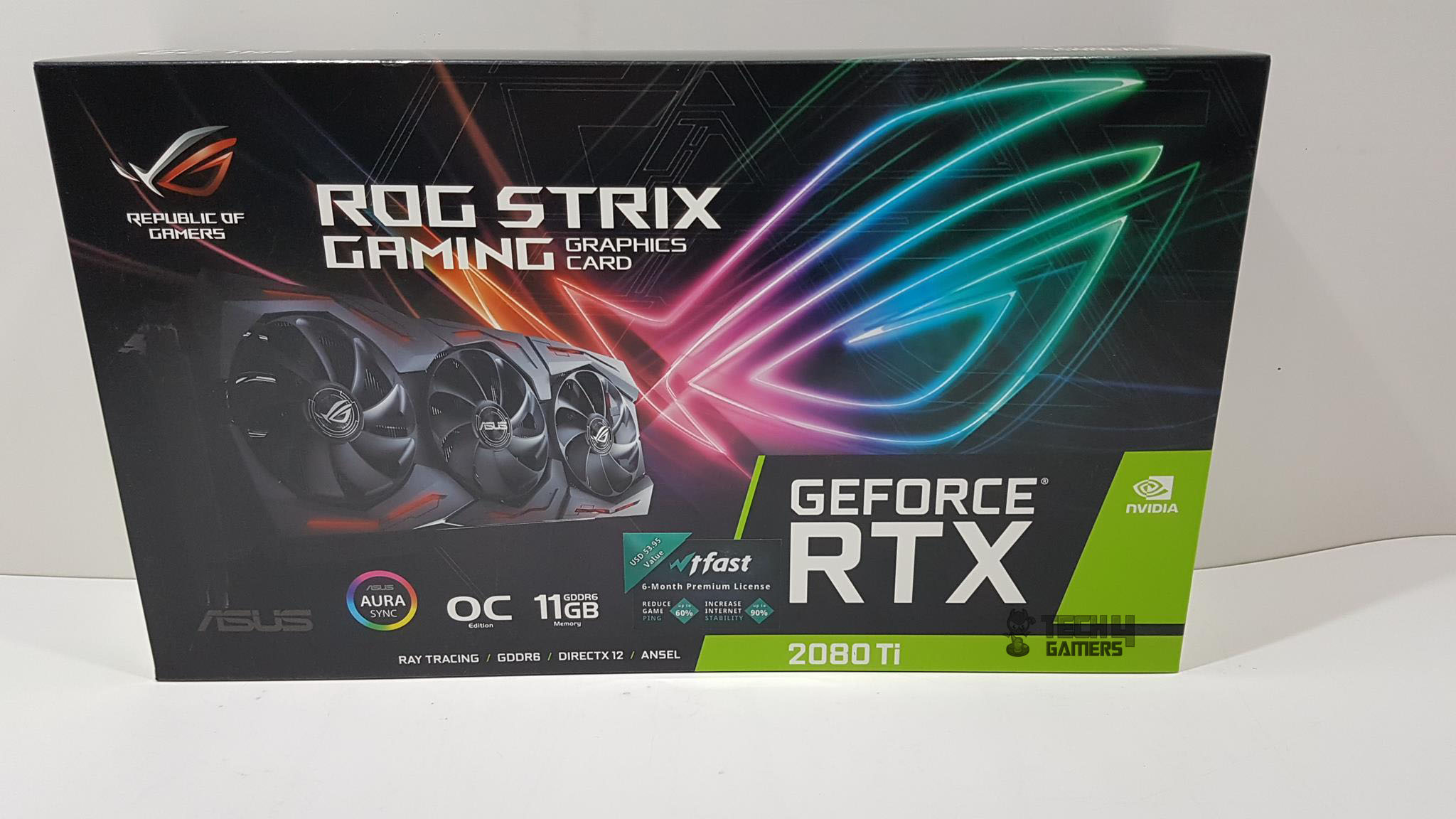
The top side of the packing box has GeForce RTX 2080Ti printed in the white and green colors. OC edition and 11GB GDDR6 are printed at the bottom. The right side has ROG brand logo and name printed.
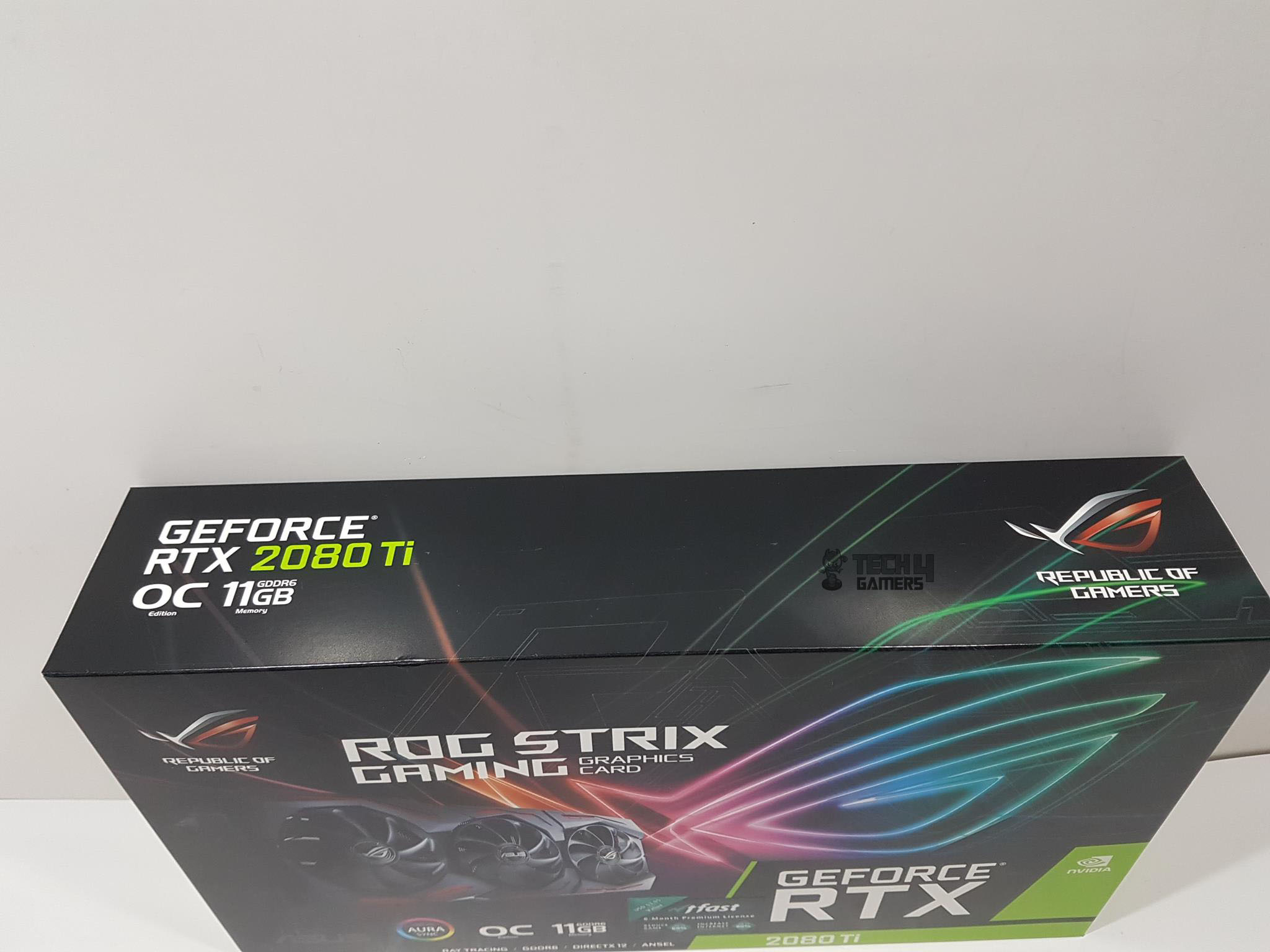
The backside of the packing box has ROG brand logo and name printed on the top left side followed by the ROG Strix Gaming Graphics Card and GeForce RTX 2080Ti text. This card carries limited 3 years of warranty. There are 6 pictures in the center focusing on the salient highlights of the graphics card like MaxContact Technology, Auto-Extreme Technology, AURA Sync Compatibility, Axial-Tech fans, Dual BIOS, and GPU Tweak II. Main specifications and key features are printed on the left side.
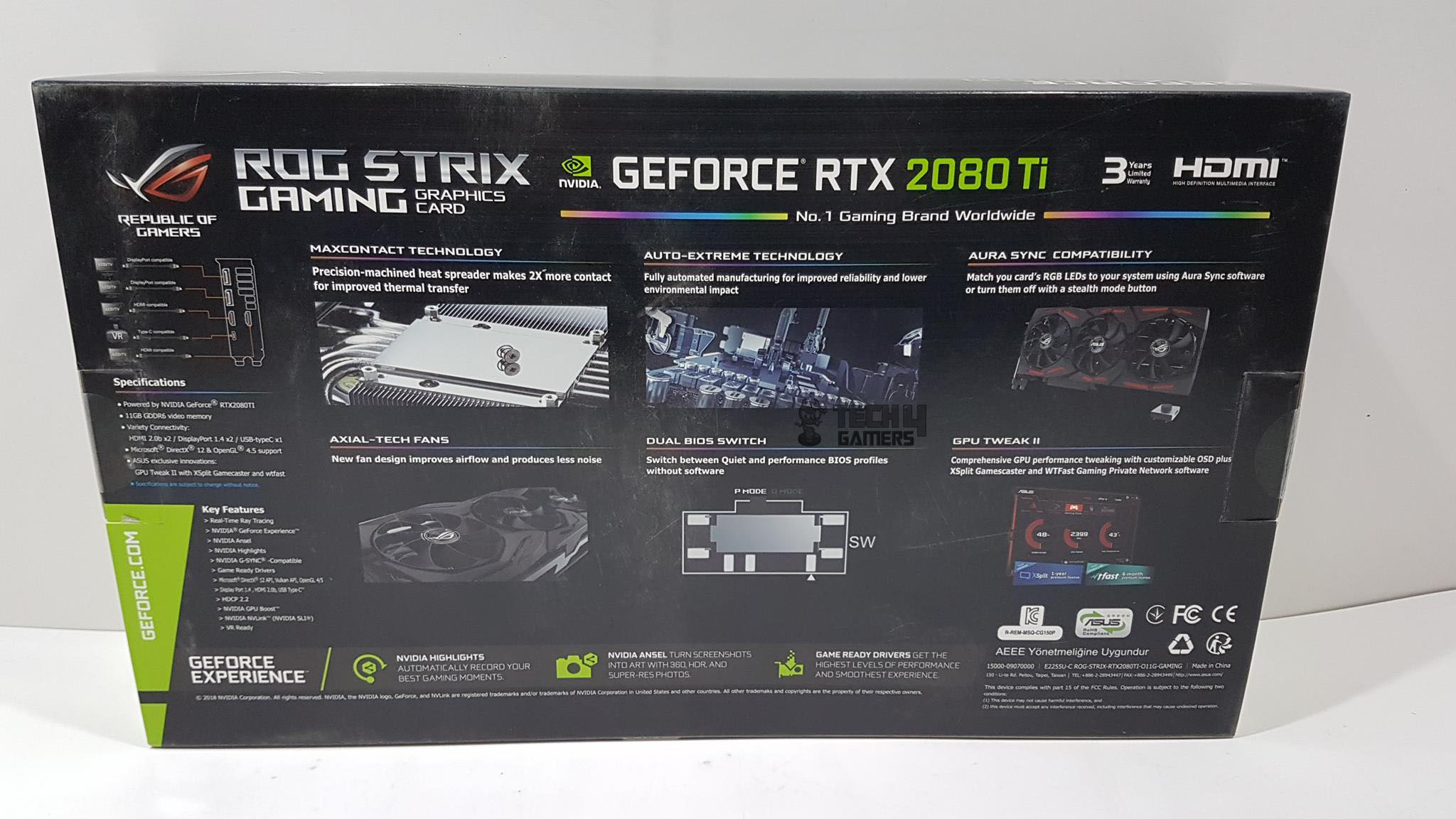
The left and right sides are identical. There is a ROG brand logo name printed on the top. ROG Strix Gaming Graphics and OC edition, 11GB GDDR6 text is printed in the middle. The lower portion has a green color background with GeForce RTX 2080Ti printed in the white color.
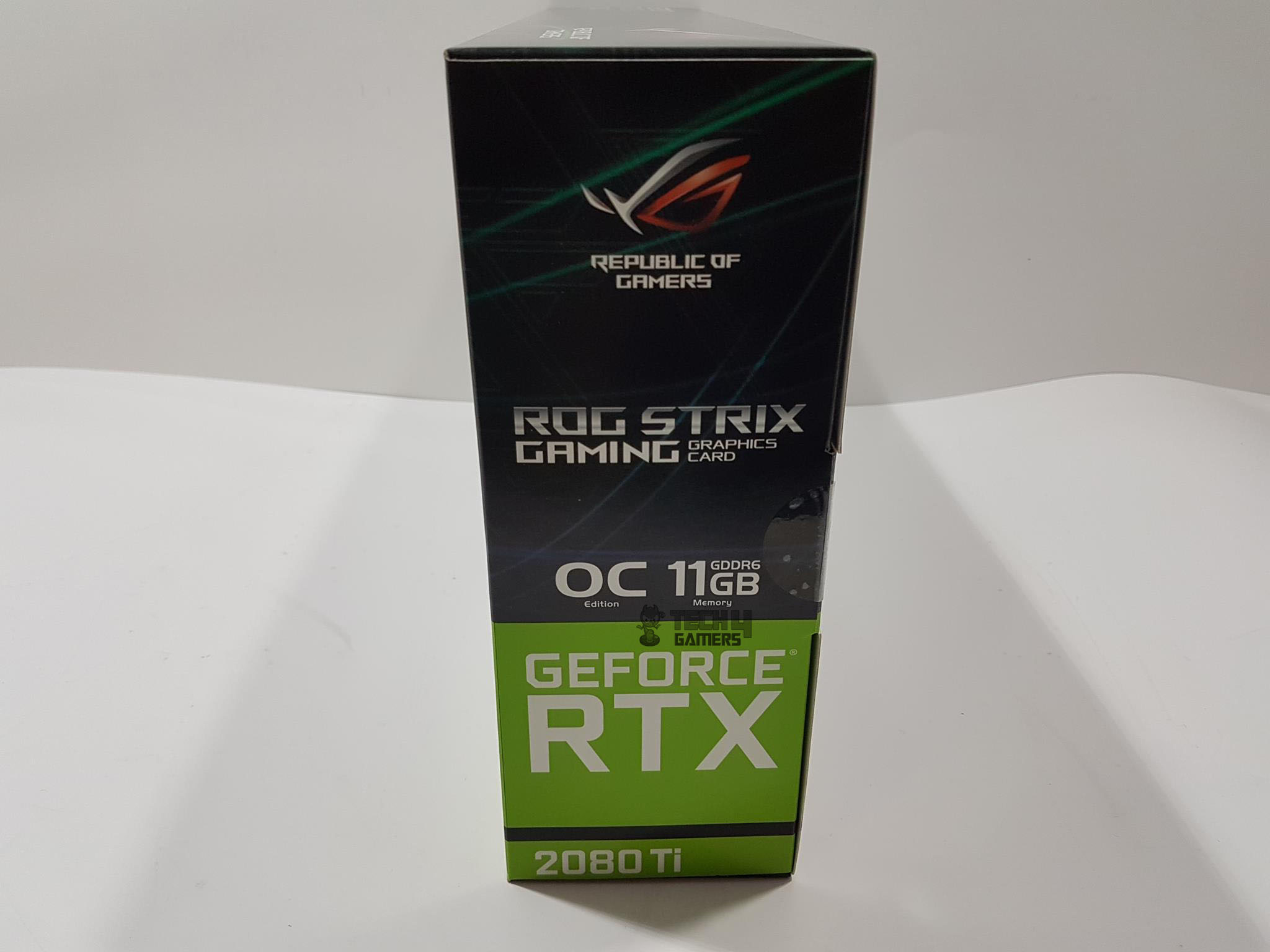
The bottom side of the packing box has minimum system requirements printed in 15 different languages. There is a sticker pasted on the right side showing the Part No, Serial No, EAN, and UPC labels and info. These requirements are: –
- Minimum 650W PSU or greater power supply.
- PCIe Compliant motherboard with dual-width graphics slot.
- 5GB of free disk space.
- 8GB System memory (16GB recommended)
- Microsoft Windows 7 x64/Microsoft Windows 10 x64 (April 2018 Update or later)
- 2x 8-pin PCIe connectors

There is a cardboard box inside the main packing box. It has Strix printed on the top cover. Opening it will show a black color Styrofoam pad placed on the top and there is container placed in the middle with Asus name printed in gold color. User guide and installation disk are inside this container. Removing this top layer will show the graphics card wrapped inside anti-static cover. Two ROG branded Velcro strips are also included.
RTX 2080Ti Contents
- 1x Asus Strix GeForce RTX 2080Ti O11G graphics card
- 2x Asus ROG branded Velcro Hook and Loop
- 1x Quick Guide
- 1x Installation disk
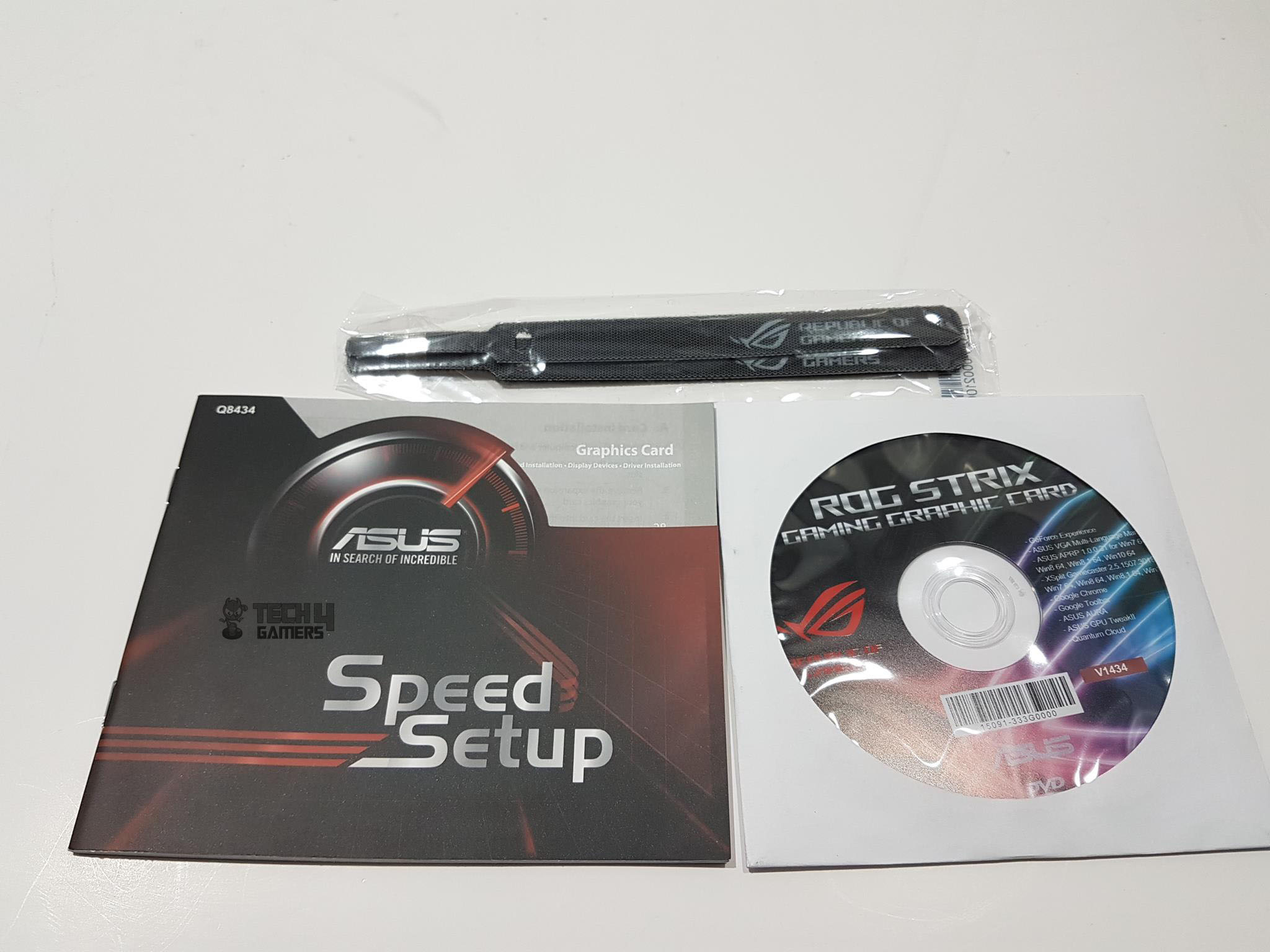
Asus ROG Strix Design and Features
It is time to take a closer look at the design of the graphics card before proceeding to the testing. Asus Strix GeForce RTX 2080Ti O11G review is a beautifully designed graphics card. It carries the same shroud design as was introduced with the release of the Pascal generation cards. It is a 2.7 slot design yet with aesthetically pleasing looks and feels to it.
Aura Sync adds the subtle touch when in operation and it speaks for itself. This design really complements the ROG series motherboards from the Asus. The dimension of the graphics card is 12×5.13×2.13 inches or 30.47×13.04×5.41 CM. The card is following the PCIe 3.0 bus interface. It packs 11GB GDDR6 memory rated at 1750MHz using 352-bit bus width at 616 GB/s bandwidth.
The base clock of the card is 1350MHz in all the modes. The default mode is Gaming Mode with 1660MHz boost clock and 1665MHz boost clock under OC Mode. Please, note that you will need to install GPU Tweak II to access these modes. BIOS switch has nothing to do with these modes. Interesting enough this card has 4352 CUDA Cores whereas fully enabled TU102 chip has 4608 CUDA cores.
Maximum supported digital resolution is 7680×4320. The card is drawing power using two 8-pin connectors. This card packs 88 ROP units and 272 TMUs. The pixel fillrate is 118.8 GP/s and Texture fillrate is 367.2 GT/s. Texture fillrate is low as compared to Nvidia’s stated minimum of 420.2 GT/s for a fully enabled TU-102.
Let’s dig deep in the design elements of this card and explore the might and the beauty of it. This card has a stylish cooler shroud that differentiates the Strix cards form others. The cooler shroud is made of hard plastic. Top and bottom cutouts on the cooler have LEDs on them which can be controlled with AURA Graphics Card software available on Asus website.
The central fan has ASUS brand name printed in white color on its fan hub whereas the other two fans have ROG Eye printed in their centers. With the curves, edges, grooves Asus not only was able to maintain the typical Strix looks it is known for but has given the user what could be described as one of the most stunning design.

Asus has taken a different approach (much needed for Turing) with the ROG Strix GeForce RTX series coolers design. They have increased the width of fin stack by adding 20% more to the surface area over the previous generation Strix cards making the design to be 2.7 slots one. This has enabled them to have more sink surface area for effective heat dissipation across the complete surface.
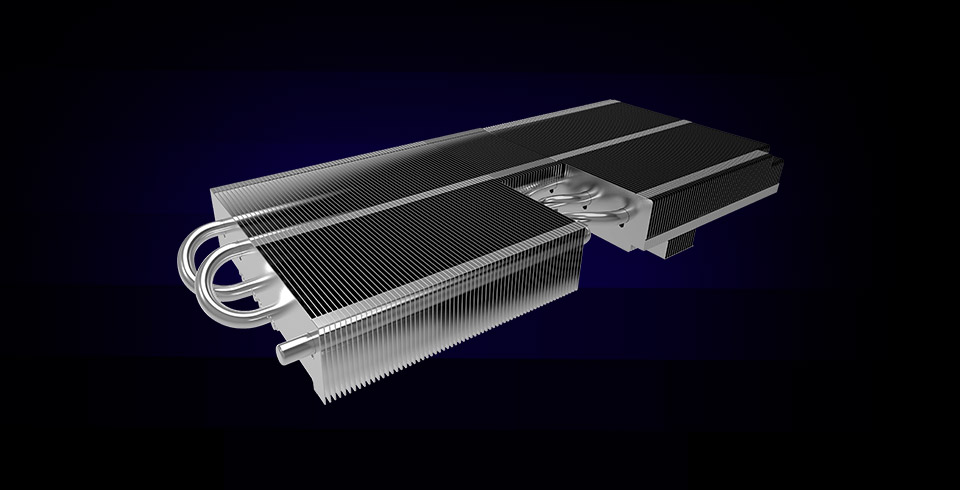
Asus MaxContact is an industry-first GPU cooling technology that features an enhanced nickel-plated copper plate that makes direct contact with the GPU. This plate is 10 times flatter than the traditional plates. MaxContact utilizes precision machining to provide a surface that makes up to 2X more contact with the GPU than traditional heat spreaders, resulting in the improved thermal transfer.
This card is using a single heatsink with aluminum fins and five 8mm (not confirmed on the thickness) nickel plated copper heat pipes. There are two nickel plated copper plates. One is making contact with the GPU and the other is making contact with the MOSEFT/VRMs of this card. The heat pipes are terminated at the front.
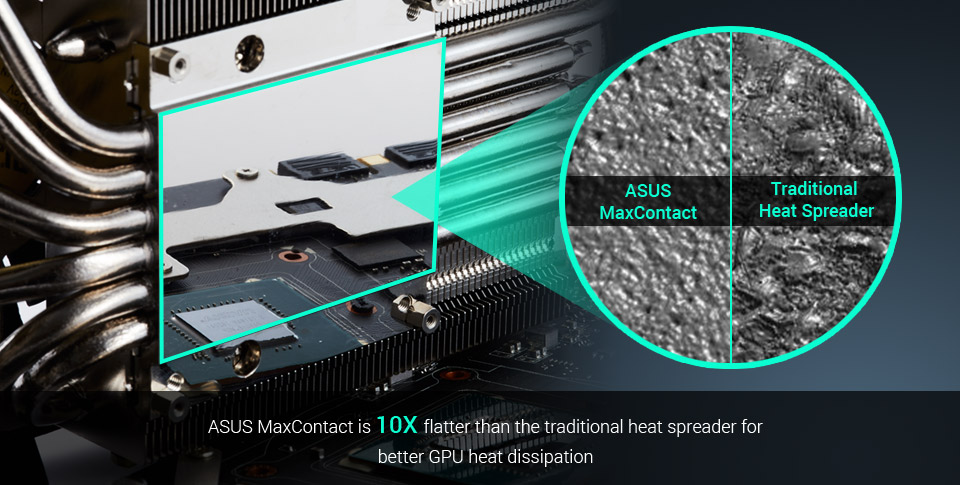
The Asus Strix GeForce RTX 2080Ti O11G Review has 3 90mm fans with an axial-tech design. The central fan has Asus branded sticker pasted in the center. The left and the right fans have ROG branded stickers pasted in the center. These fans have the IP5X certification which means they are more dust resistant which would improve their reliability and a longer lifespan.
The previous generation of Strix cards has the wing-blade design. This time around, Asus has come up with the Axia-Tech fans which are delivering up to 27% increase airflow and 40% increased static pressure. This was a needed requirement as the width of the heatsink has been increased resultantly, stronger fans with high static pressure and airflow were needed.
Asus has reduced the size of the fan’s hub to allow for longer blades and added a barrier ring that increases structural integrity and downward air pressure through the heatsink. These fans are using the Asus 0dB technology. Please, note that due to dual BIOS nature the 0dB works under the Q-Mode only. They don’t spin until the temperature exceeds 55°C.
If you want to enable the 0dB technology for P-mode then use GPU Tweak-II to enable it. This particular card, on the other hand, seems an exception to that as fans were not spinning until the temperature hits 55°C in P-mode. Seems to me more of an anomaly.
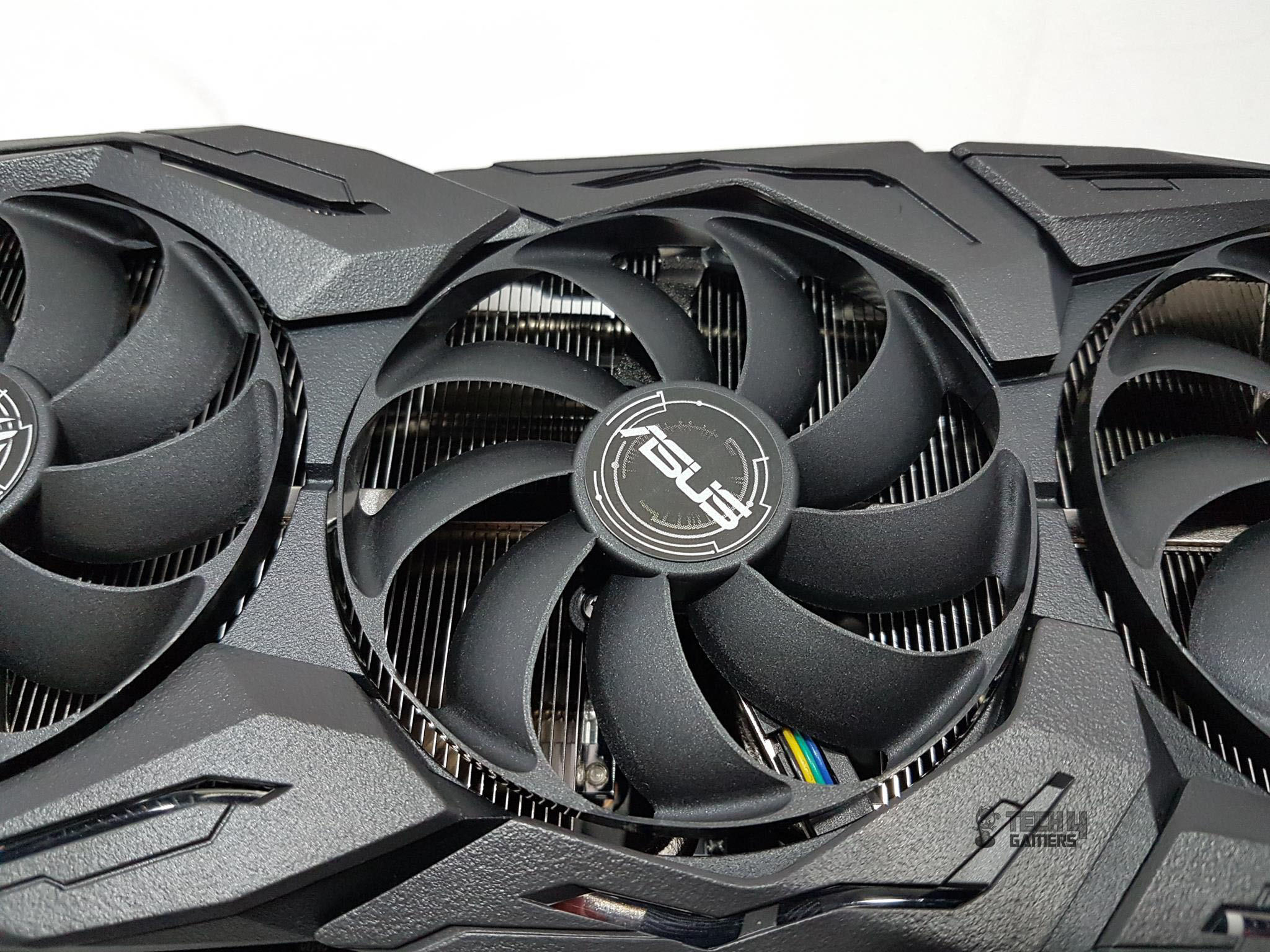
As mentioned above, among the key differentiating design features of this card over the previous generation is the Dual BIOS implementation. The Asus Strix GeForce RTX 20xx cards come with two BIOS.
In order to differentiate the two, they are labeled as P-Mode and Q-Mode. P-Mode focuses on the performance with adequate cooling over the acoustic whereas the Q-Mode is focused on the silent operations which come at the cost of thermal performance. I have tested the thermal performance of the graphics card under both modes which can be checked in the testing section.
There is a switch on the top side of the PCB. P-Mode is on the left side and the Q-Mode is on the right side. The default mode is P-mode. Another important observation is that once the Windows is loaded, switching to the other BIOS will not take effect until the PC is restarted. Below picture highlights the effects on temperature and acoustics in both modes. Asus in-house testing is showing the graphics card to be 27% cooler in P-Mode over the Q-Mode. Similarly, the graphics card is 13% quieter in Q-Mode.

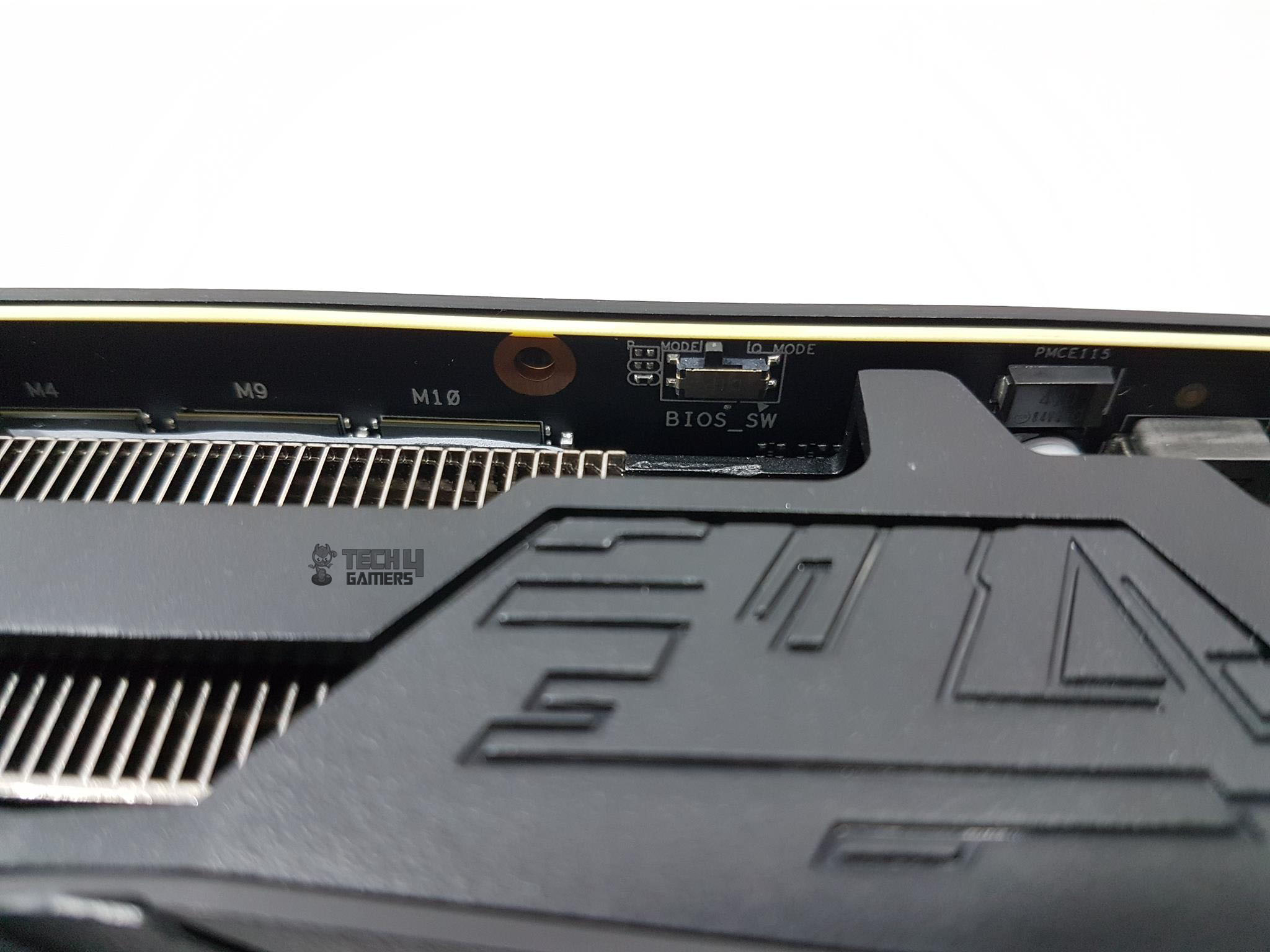
Another key design feature is the provision of the LED On/Off button located on the backside of the graphics card. This will allow the users to turn the RGB lighting completely on or off at their disposal. This was not possible in the previous design. Seems, Asus has taken the note of the feedback by the users. This somehow has a limitation as well. It will disable/enable the entire lighting zones on the card.
There are three zones. One on the ROG Eye located on the backplate, one on the top side and one on the shroud itself. There is no control over the dedicated zones lighting. Builders/gamers who would prefer stealth look would appreciate this feature.
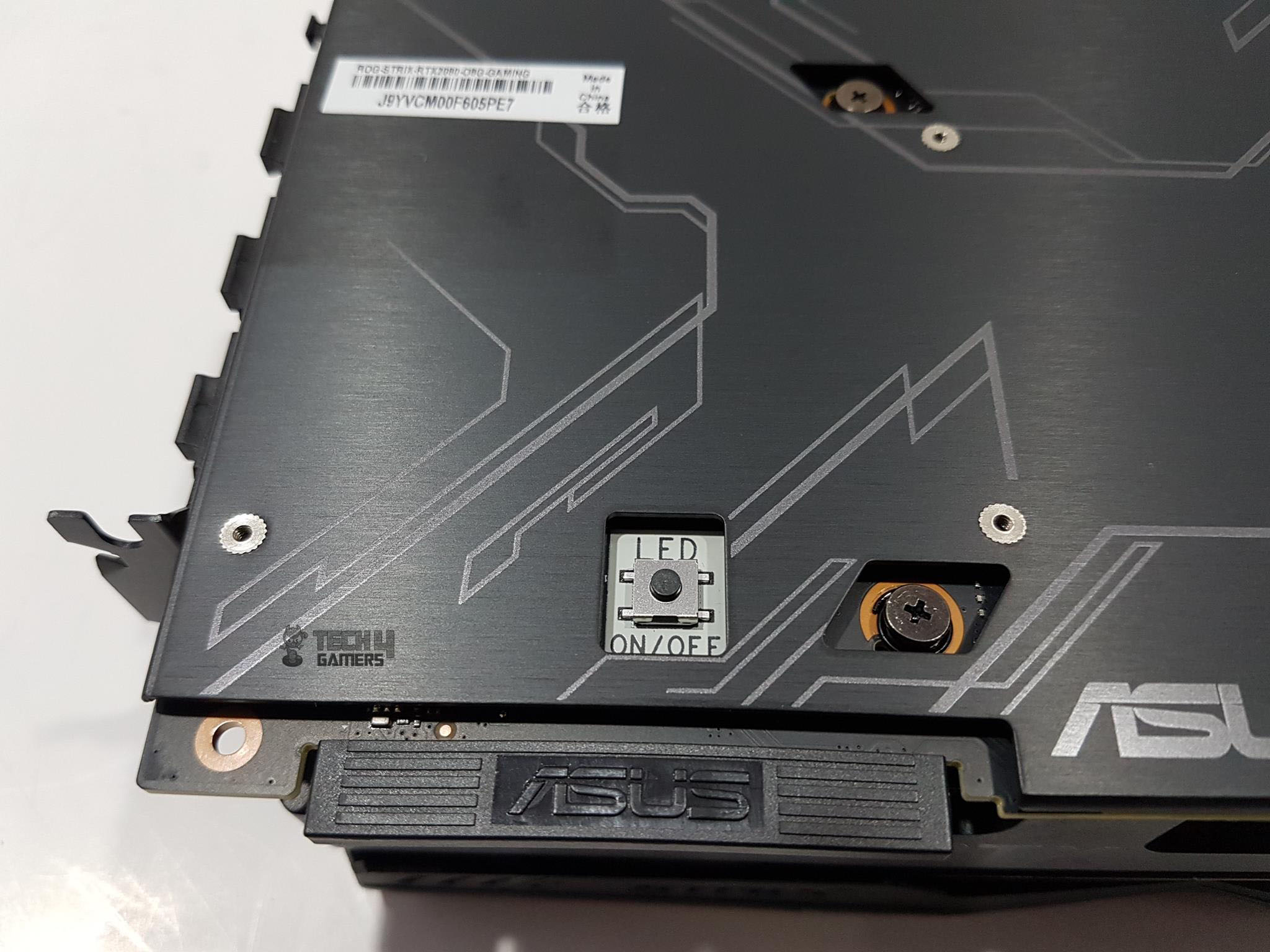
Let’s take a look on the top side of the graphics card. STRIX is printed on the lower left part of the shroud. GeForce RTX is printed on the upper part of the shroud opposing the STRIX. The fins are straight design not angular. Shroud is not fully covering the fin stack which is a must for effective heat dissipation.
“Republic of Gamers” brand name and logo are on the top left side of the shroud. They have LED underneath and light up under operation. Asus has implemented reinforced frame in this generation of Strix cards which has increased the structural integrity of these cards 3X by using a metal brace which is mounted to both backplate and I/O shield. This metal brace prevents excessive torsion and lateral bending of the PCB.
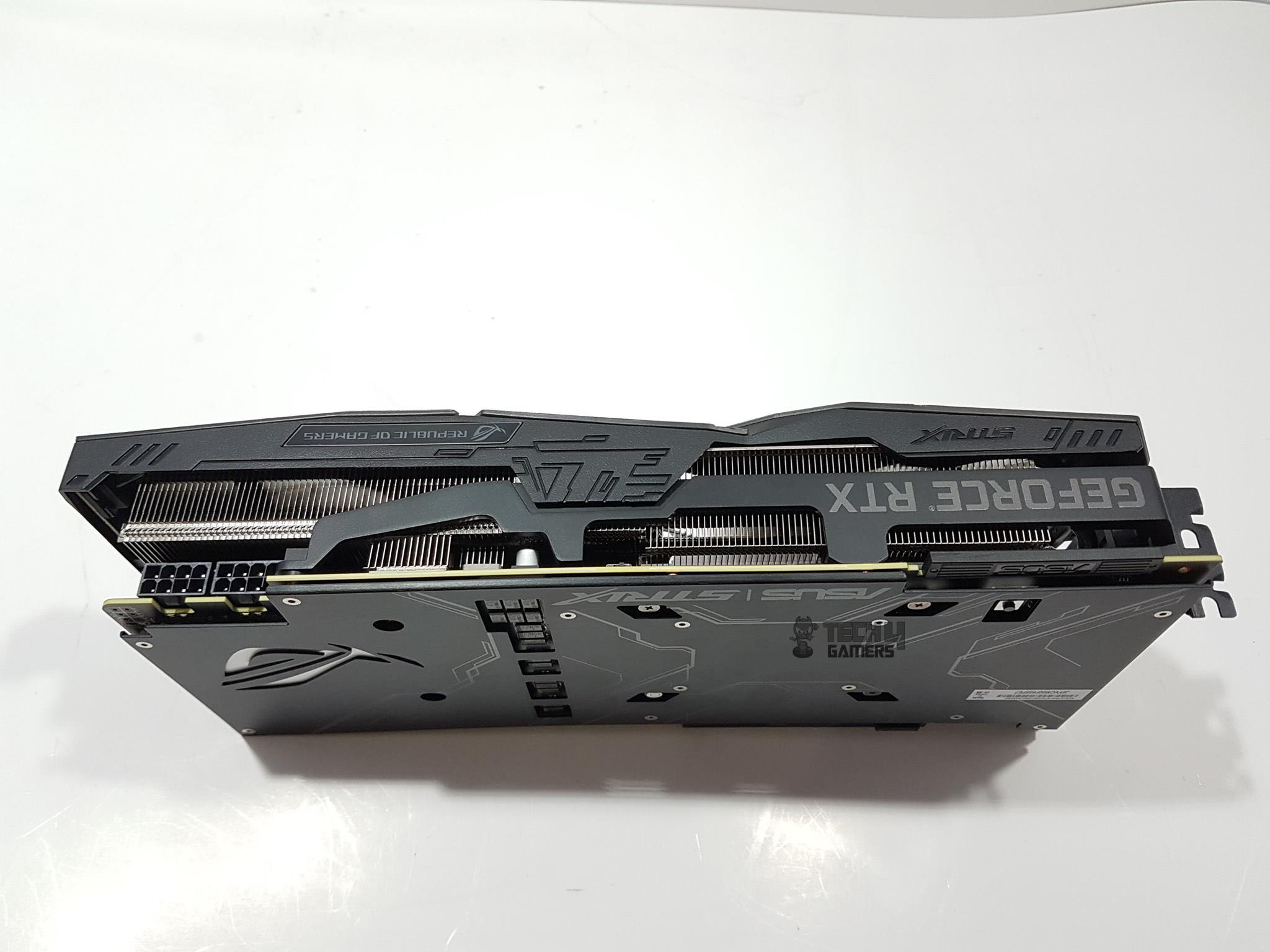
The card requires two 8-pin power connectors to power it up. Both connectors have LEDs beneath them to indicate their action. Static white color would mean the normal power. The red light would indicate the power related issue.
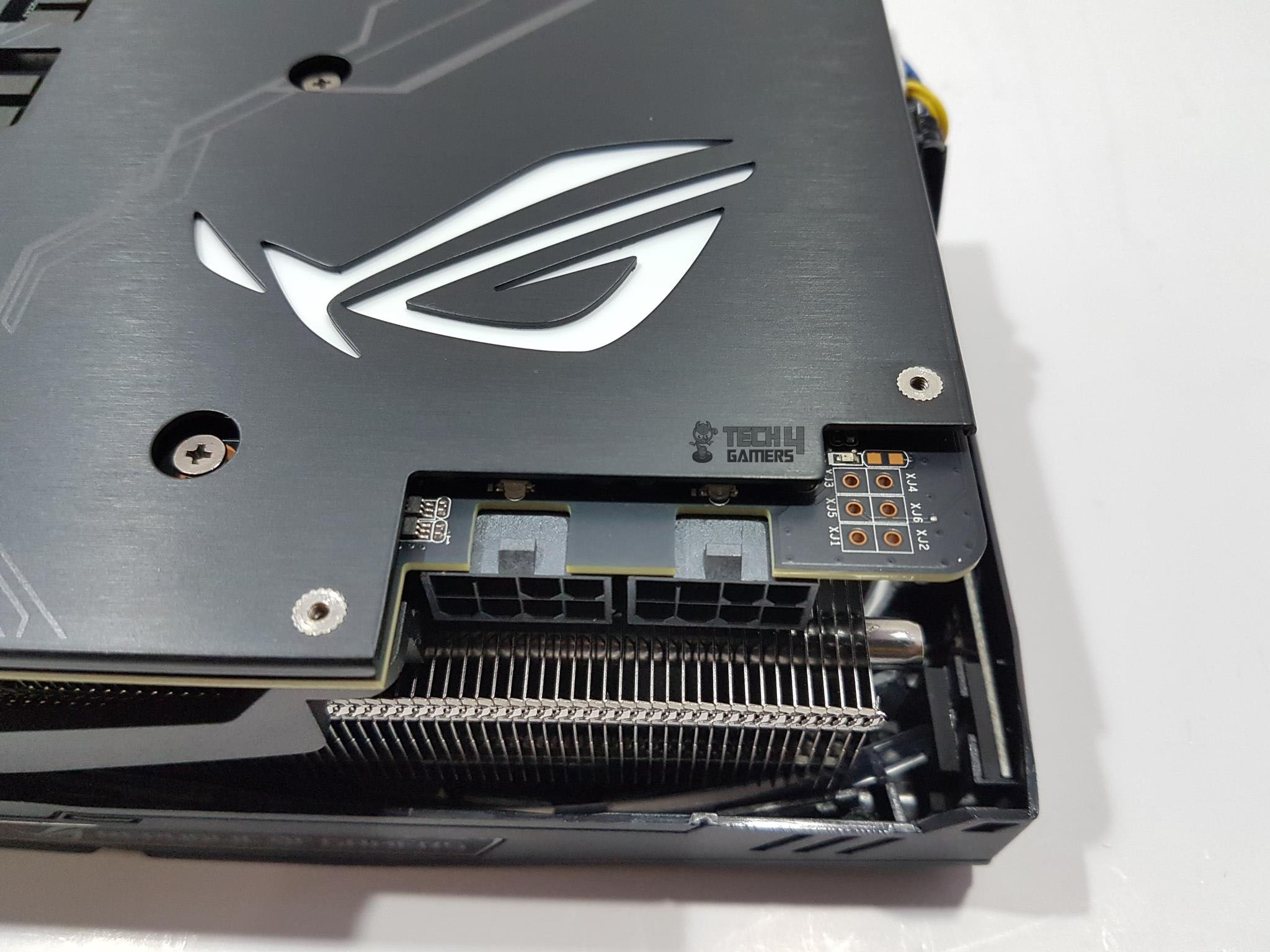
Let’s have a look at the front side of the graphics card. The Shroud’s end is not fully covering the heat sink. Heads or terminating ends of the 5 heat pipes are visible. Underneath we can see a provision of mounting two fan headers but the headers themselves are missing.
Since I did not open the card, so I am not sure if the PCB has sub-components to accommodate the future implementation of the PWM headers, however, the quick look on the headers’ site gives the impression that provision is there. One fan power connector and the RGB LED power connector are visible on the left side. There is a 4-pin RGB header having 12V GRB pin format. The user can connect supported RGB LED strip with the graphics card as well.
This will come handy when using on the Asus AURA Sync enabled motherboard and in that particular scenario think of it as adding one more AURA lighting header at the user’s disposal. This end of the shroud has extended over the PCB and the heat sink which adds to the looks of the card from the front side and gives the impression of one complete design.
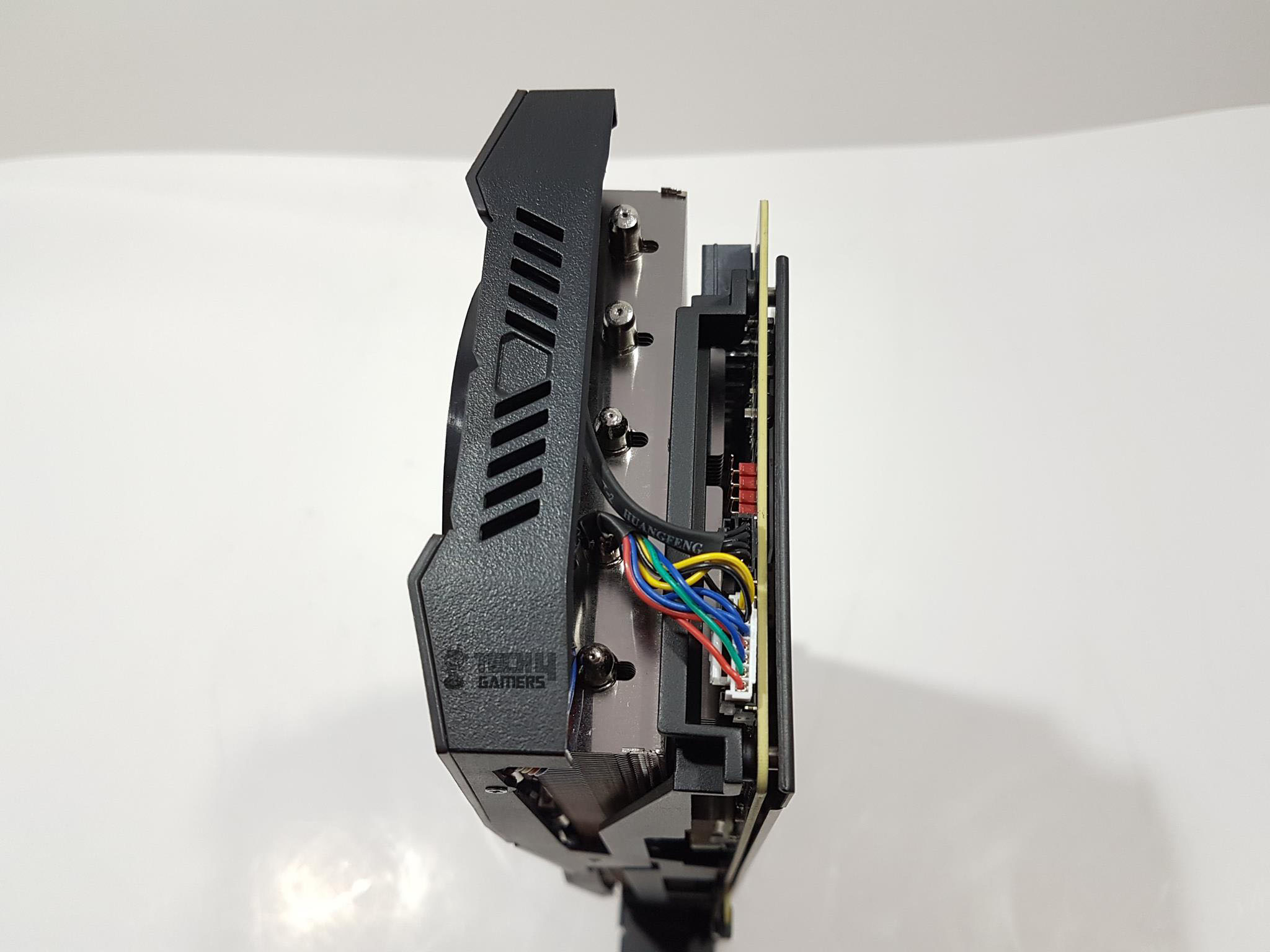
On the back side of the graphics card, we have the same metal backplate as has been on the previous generation. It has printed lines in a pattern to signify Strix concept. We’ve a large size ROG Eye in the white background which is basically a diffuser. This section is implemented with RGB LED and really adds to the cool looks on the card when in use.
We can see two 8-pin power connectors. There are what seem to be soldered overclocking tweaking points on the left side of the power connectors. One of the screws on the GPU bracket is covered with a white sticker. Peeling or tearing that would void the warranty though recently warranty terms have been redefined dropping this requirement in the US region. I am not sure if this is done worldwide yet.
There is a sticker pasted on the bottom right side with the serial no of the card. The LED on/off button is located under the NVLink connector. As mentioned in the introduction, the Turing based graphics cards have been implemented with NVLink that enables the multiple-GPU configuration at much higher bandwidth up to 100 GB/s bi-directional for the TU102 GPUs. Though I did not open the card, it seems like there is no thermal pad between the backplate and PCB.
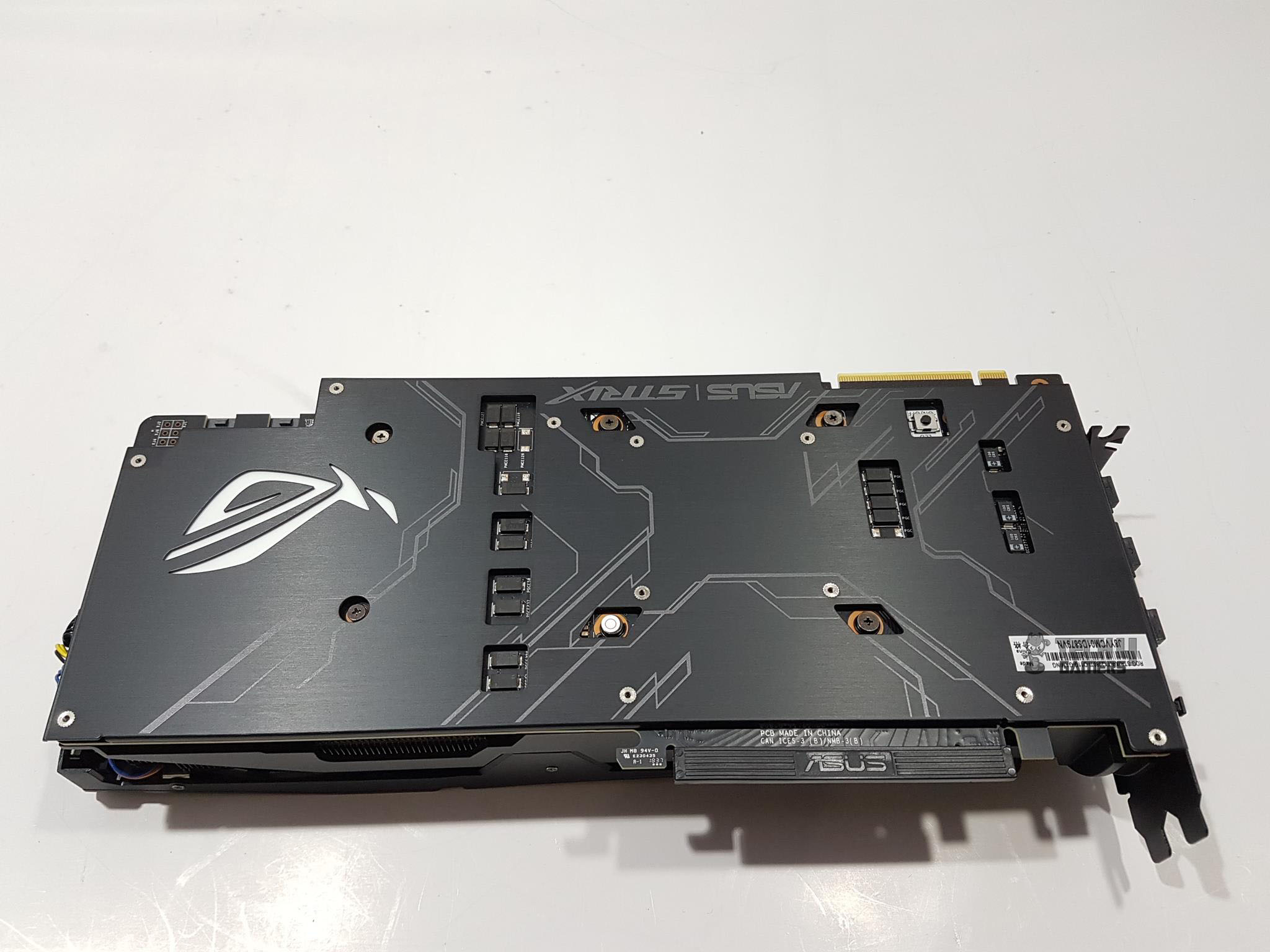
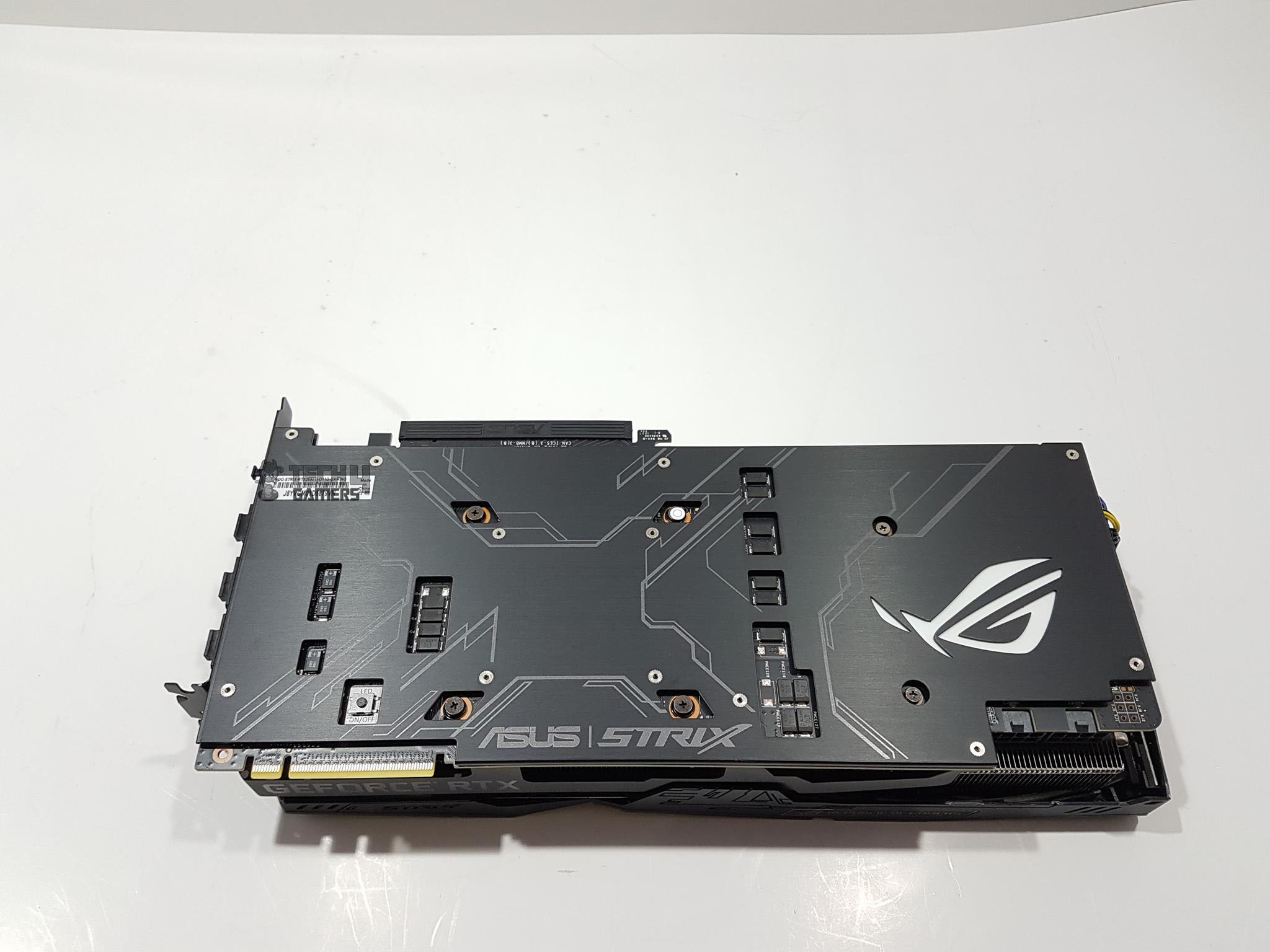
The rear side has the I/O shield for the output. It is not in a silver color as Nvidia has opted for a black color I/O shield on their RTX cards which definitely adds to the overall look and feel of the graphics card. We have two HDMI 2.0b ports, two DisplayPort 1.4 ports, and a USB Type-C port.
This configuration allows the user to enjoy immersive virtual reality experiences anytime without having to swap cables by having a VR Device connected with other displays at the same time. Backside implementation allows the better cable management as well.
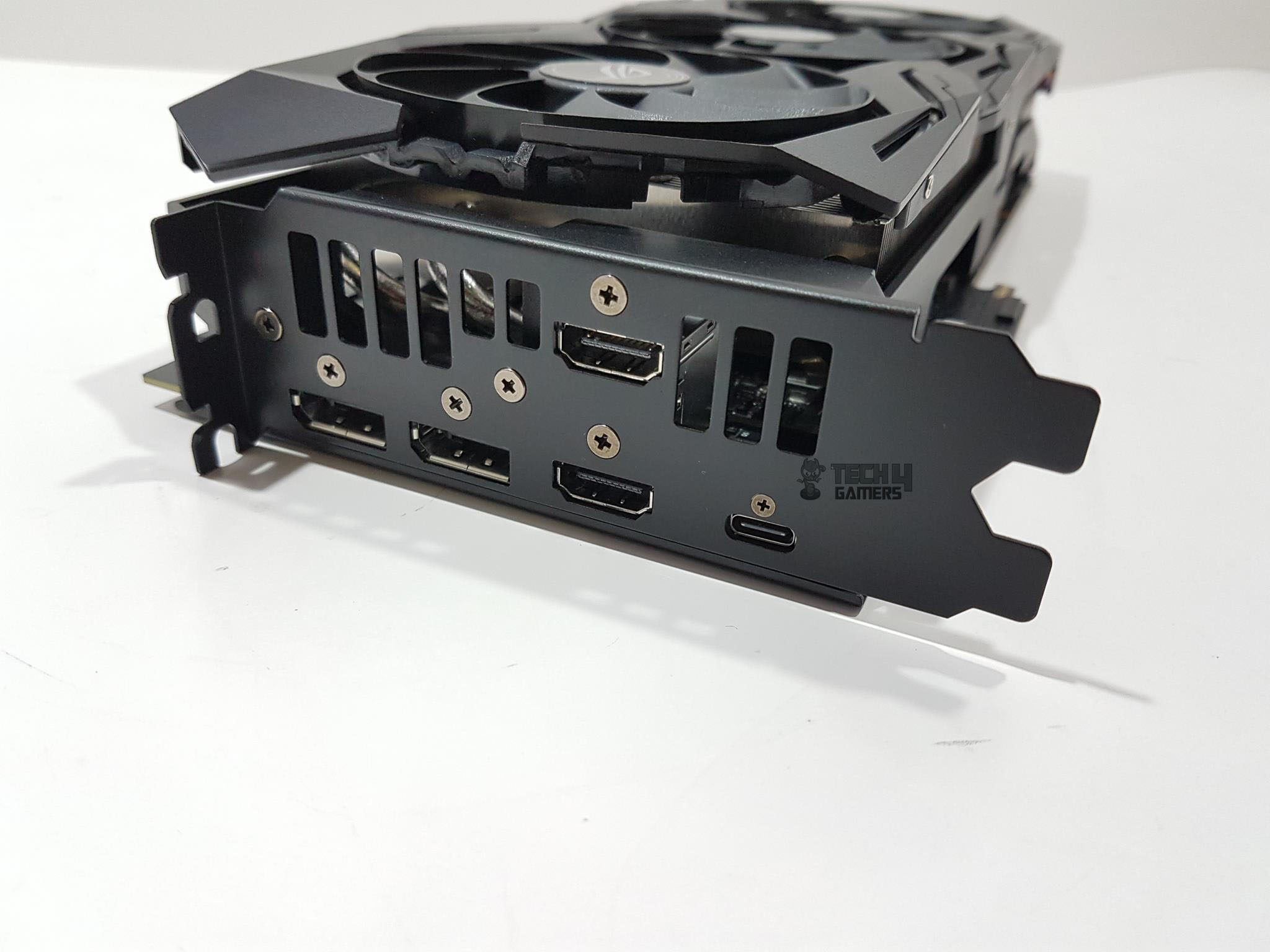
The bottom side of the card clearly shows the two fin stacks on the cooler. Thermal pads have been used on the possible point of contacts between PCB and the cooler. PCB color is black.

ASUS graphics cards are produced using Auto-Extreme Technology, an industry-exclusive, 100% automated production process that incorporates premium materials to set a new standard of quality. Auto-Extreme Technology ensures consistent graphics card quality as well as improved performance and longevity.
It allows the soldering to be done in a single pass reducing thermal strain on the components and avoiding the use of harsh cleaning chemicals. The end result is a less environmental impact, lower manufacturing power consumption, and a more reliable product.
The Asus Strix GeForce RTX 2080Ti O11G has 16+3 power phases using Super Alloy Power II components. These components would enhance efficiency, reduce power loss and would achieve sustained thermal levels. They are using SAP II capacitors having a 2.5X extended lifespan (over 90000 hours longer than standard capacitors), SAP II chokes to help to reduce the buzzing, SAP II DrMos for lower temperature and increased power efficiency and SAP II POSCAP to maximize overclocking headroom.
GeForce RTX 2080ti Aura Sync
Featuring Aura RGB Lighting on both the shroud and the back plate, ROG Strix graphics cards are capable of displaying millions of colors and six different effects for a personalized gaming system. ROG Strix graphics cards also feature ASUS Aura Sync, RGB LED synchronization technology that enables complete gaming system personalization when the graphics card is paired with an Aura-enabled gaming motherboard. There are 6 modes which user can configure and select for the color effect.
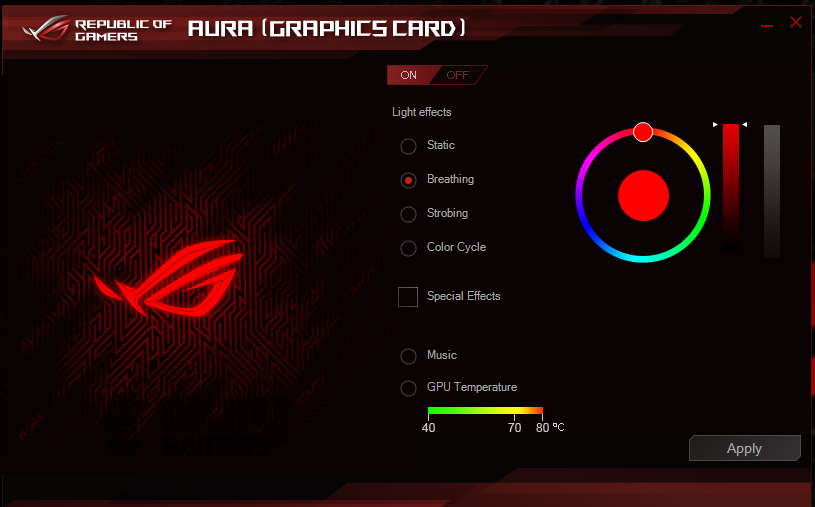
- Static mode. A single color of user’s choice would remain lit.
- Breathing mode would fade in and out the user’s selected color.
- Strobing mode flashes the user’s selected color.
- Music Effect mode would produce the pulses of the user’s selected color.
- Breathing mode will enable the user to select the color which will be then faded in and out.
- GPU Temperature will change the color depending upon the load and the temps under the loads.
GPU Tweak II
Asus has designed comprehensive software to control and monitor their graphics cards. This software is known as GPU-Tweak-II. It has a typical red and black color theme on it which represents ROG traditional colors. Though in recent times, ROG has taken a deviation from the Red/Black combo and is setting yet another tradition when it comes to colors on the brand.


The main window of the software shows three main indicators which are: –
- VRAM Usage
- GPU Speed
- Temperature
The red bar on these circles shows the corresponding value of the indicator. On top, we have model no of the graphics card on the left side with three buttons to its right, Home, Info and Tools.
The home button is a default and can be clicked at any time to bring the main window back on the screen. Info button will show the Graphics Cards specs with built-in GPU-Z implementation. Tools button has Game XSplit Game Caster, AURA Graphics Card and the ROG Furmark buttons to launch the corresponding app.


Below the model no, we have a triangle featuring the blend of most important factors that end user would want. They are Performance, Coolness, and Silence. An optimal combination of these three is what Strix is all about. One can have the utmost performance with exceptional cooling yet silent operations. Red color span within triangle would vary with each profile showing how the card would manage all three with the respective profile.
Next, we have 4 profiles which are OC Mode, Gaming Mode, Silent Mode, and My Profile. Gaming is a default mode with a base clock of 1350MHz and boost clock of 1660MHz. OC Mode has a base clock of 1350MHz and boost clock of 1665MHz. My Profile will allow the user to create a custom profile based on the user’s own settings.
This can be done in Professional Mode where all the settings like Voltage Control, Power Level, Base Clock, Memory Clock, Fan Speed can be configured. The fan can be set on Auto or Custom fan curve.

Monitoring window can be activated by clicking on the Monitoring button at the bottom left side of the main window. Monitoring window shows all the critical variables for monitoring. Values are mentioned in Min, Max and Current value is shown on the graph.
The user has the option to monitor only the desired variables. Monitoring window can be disconnected from the main window by clicking once on the chain button between both windows. This is where the user can also control the fans (if any) connected to the graphics card’s fan headers. Be default OSD is disabled, If you want to avail this feature then click on OSD to enable it.
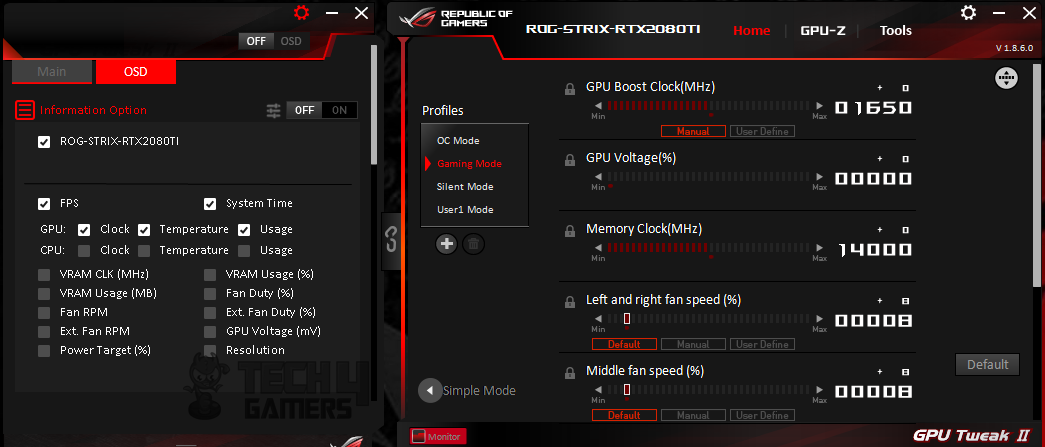

Gaming Booster option is at the bottom of the main window. Clicking this would open a new window. Here we’ve three options. Visual Effects, System Services, System Memory Defragmentation. Visual effects reduce the windows visual flares like animations, animated themes to reduce the performance hit these settings could have on the performance.
System Services would allow stopping the not needed services to boost the performance. System memory defragmentation would help restore the wasted memory space and would boost the application handling.
In crux, this software has everything, the user would have dreamt of to monitor and control their graphics cards. Plus, an interface is easy to understand and once, you have launched it, it will get you going.
Test Bench
Following test bench setup is used:
- Intel i7 8700k @ 5.0GHz using 1.350V
- Asus Strix Z390-E Gaming
- Ballistix Elite 4x4GB @ 3000MHz
- Deepcool Castle 240 AIO
- Thermaltake TP RGB 750W Gold PSU
- HyperX 120GB SSD
- Seagate Barracuda 2TB for games
Following games have been tested:
- Battlefield 1 [DX11, DX12]
- DOOM [Vulkan]
- Grand Theft Auto V
- Metro Last Light Redux
- Far Cry 5
- Assassin’s Creed Origin
- The Witcher 3
- Rise of the Tomb Raider [DX11, DX12]
- Shadow of the Tomb Raider [DX11, DX12]
- Middle Earth: Shadow of War
- Ashes of Singularity: Escalation [DX11, DX12]
Software information is as under:
- MSI Afterburner v4.50
- HWInfo 64 v 5.88-3510
- 3DMark
- Unigine Superposition
For GeForce GTX graphics card, Nvidia’s driver 398.36 are used and for GeForce RTX graphics cards, Nvidia’s 411.70 drivers are used. Microsoft Windows 10 x64 version 1607 was used. All the reported framerates are average. Previously Unigine Heaven and Valley were a part of our testing but they have been dropped in favor of superposition.
The performance of this card has been tested on 1440p and 2160p. Primarily, I’ll be comparing the Asus Strix GeForce RTX 2080Ti O11G with the Asus Strix GeForce GTX 1080Ti O11G. Let’s take a look on performance graphs.
3DMark
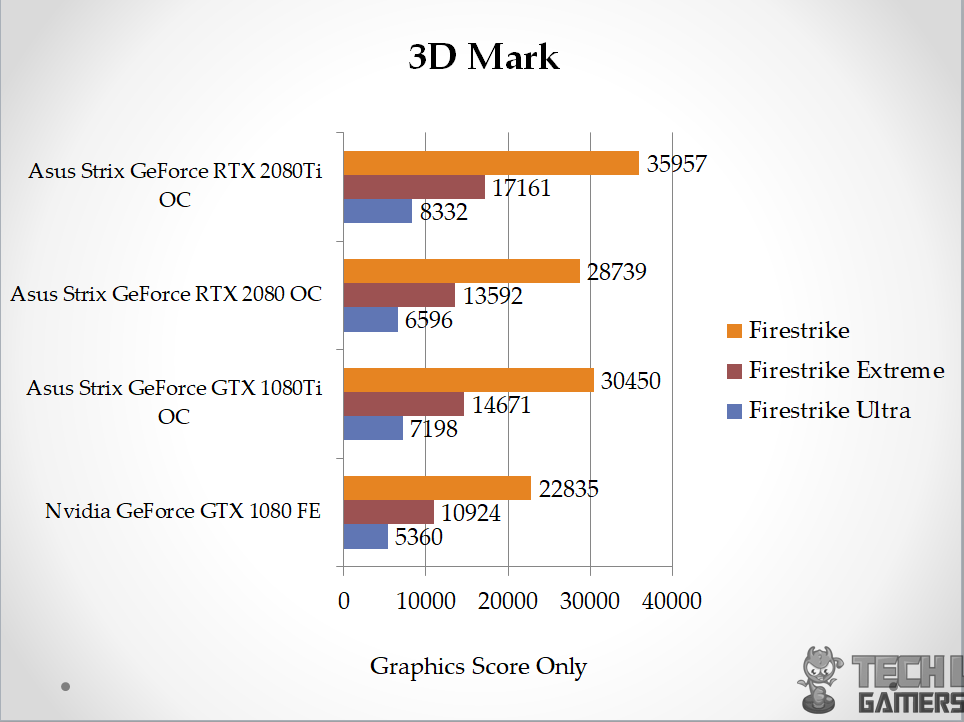
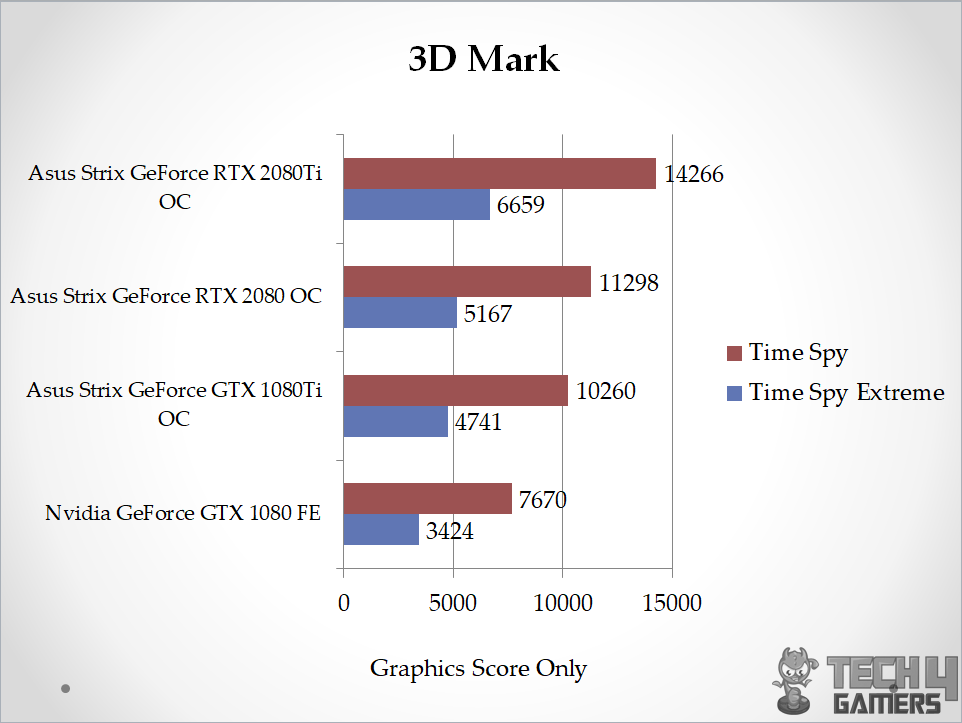
Unigine Superposition
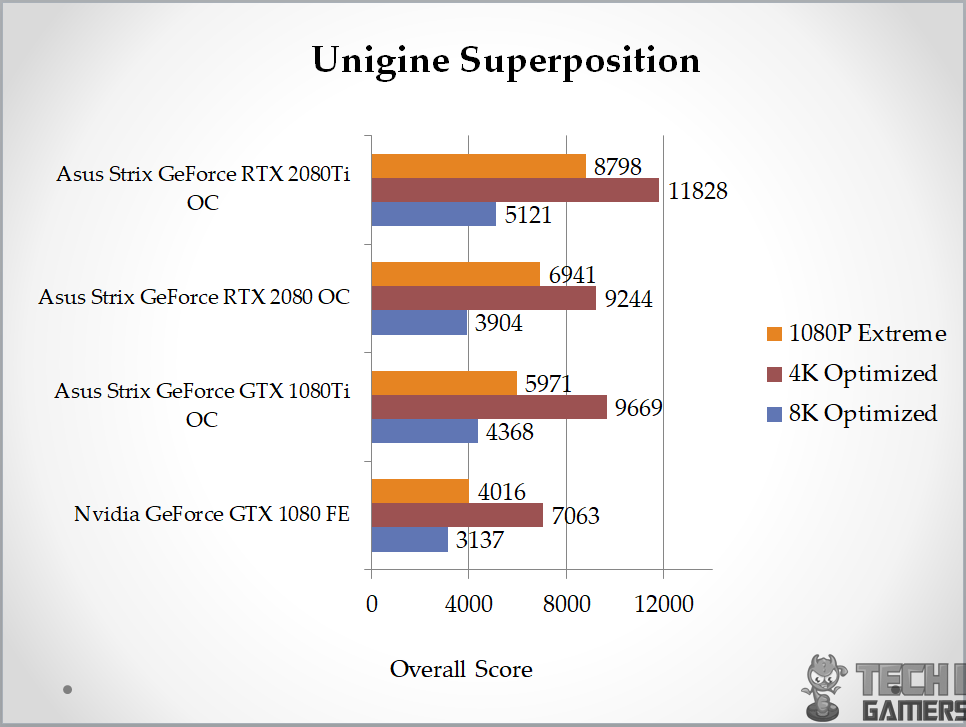
Battlefield 1 DX11
On 1440p, the performance gain is 21.06%. At 4K, the performance gain is maximum i.e 33.12%. Over 100 FPS at 4k sounds about right.
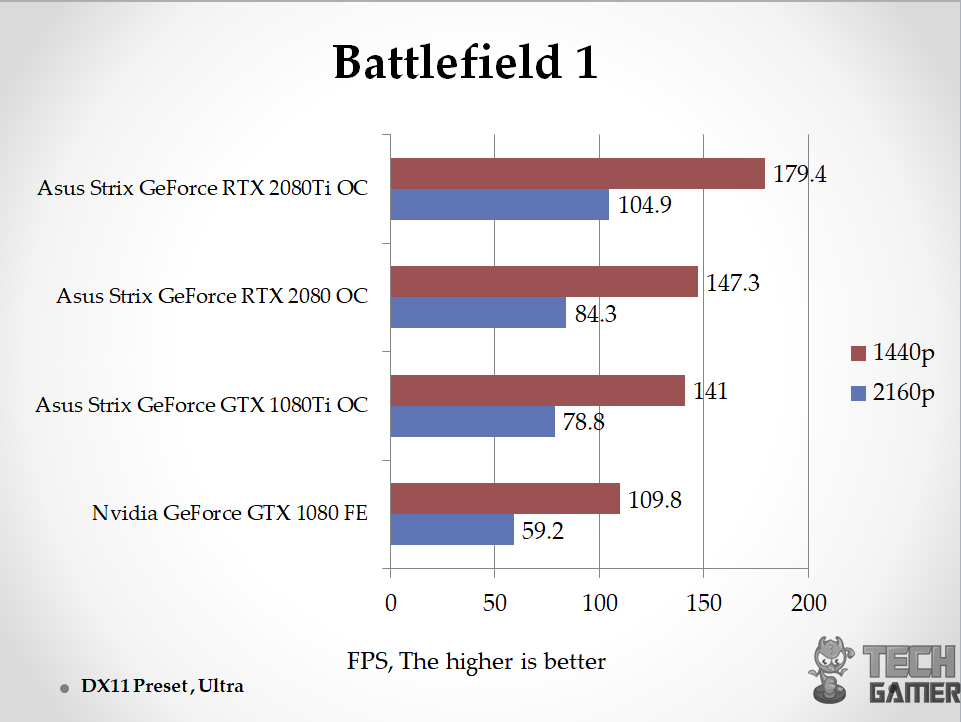
Battlefield 1 DX12
On 1440p, the performance gain is 34.98%. At 4K, the performance gain is maximum i.e 34.17%.
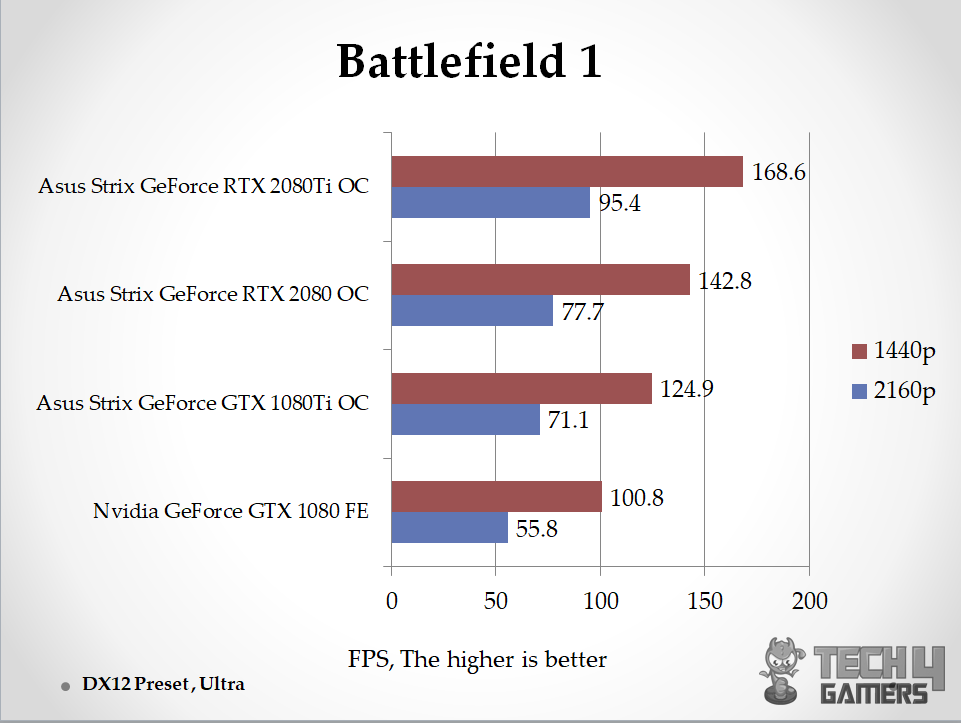
DOOM
This card was hitting 200 FPS cap on 1440p. So real, performance testing result would come from 4K testing. At 4K, the performance gain is 24.61%.
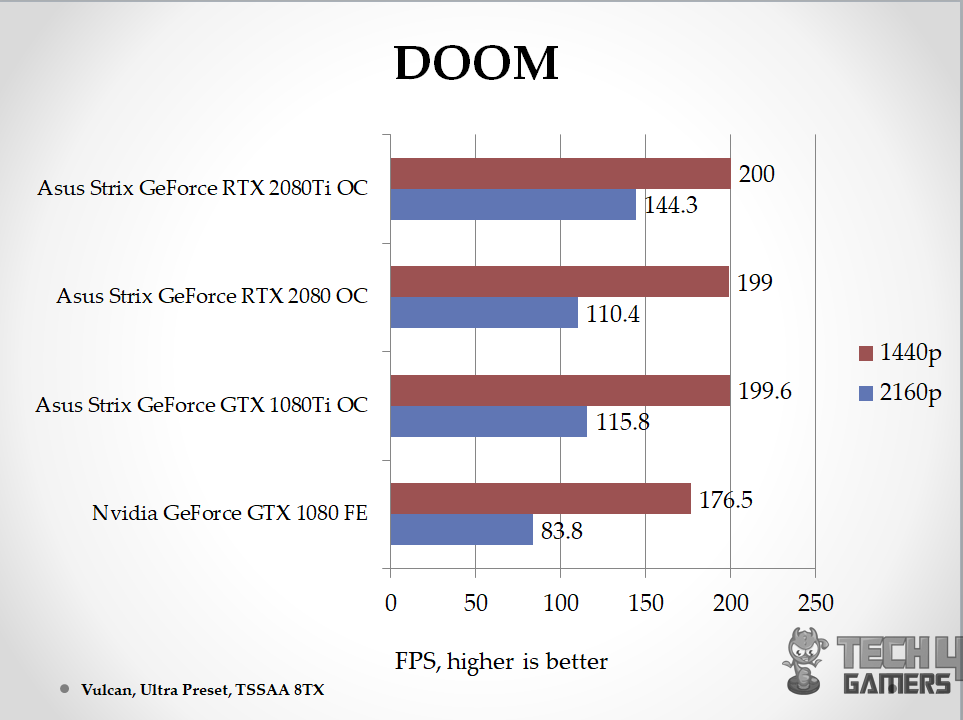
Metro Last Light Redux
On 1440p, the performance gain is 32.91%. At 4K, the performance gain is 45.45%. This is the game in which I still have to see a single card bringing 60 FPS at maxed out settings on 4k on my test bench.
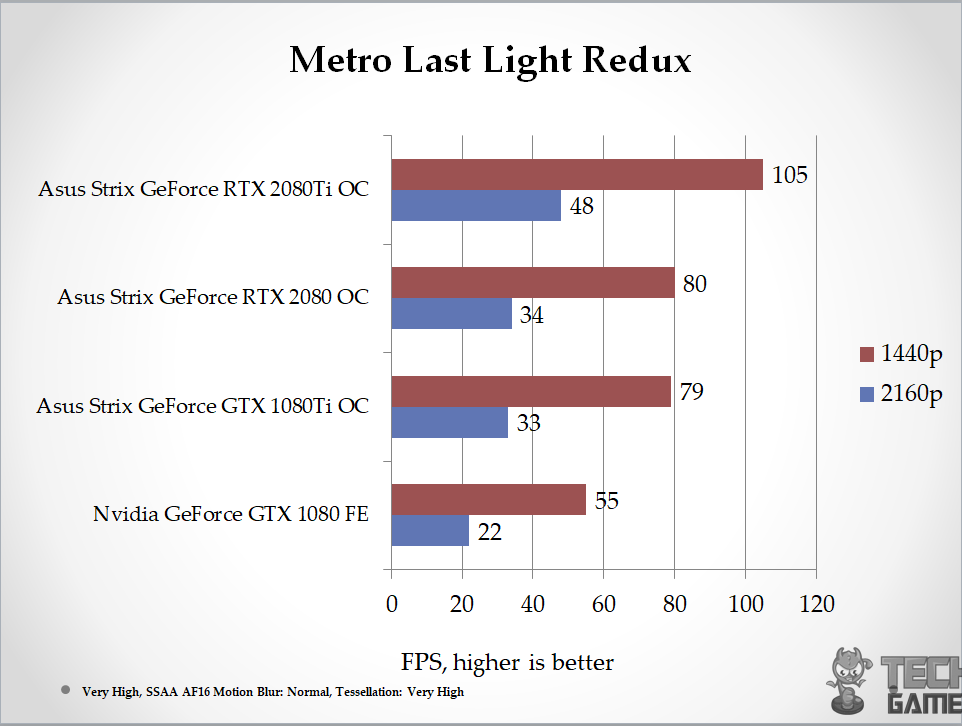
Grand Theft Auto – V
On 1440p, the performance gain is mere 16.14%. At 4K, the performance gain is 17.32%. Despite the lower margin, we have 60 FPS possible gameplay.
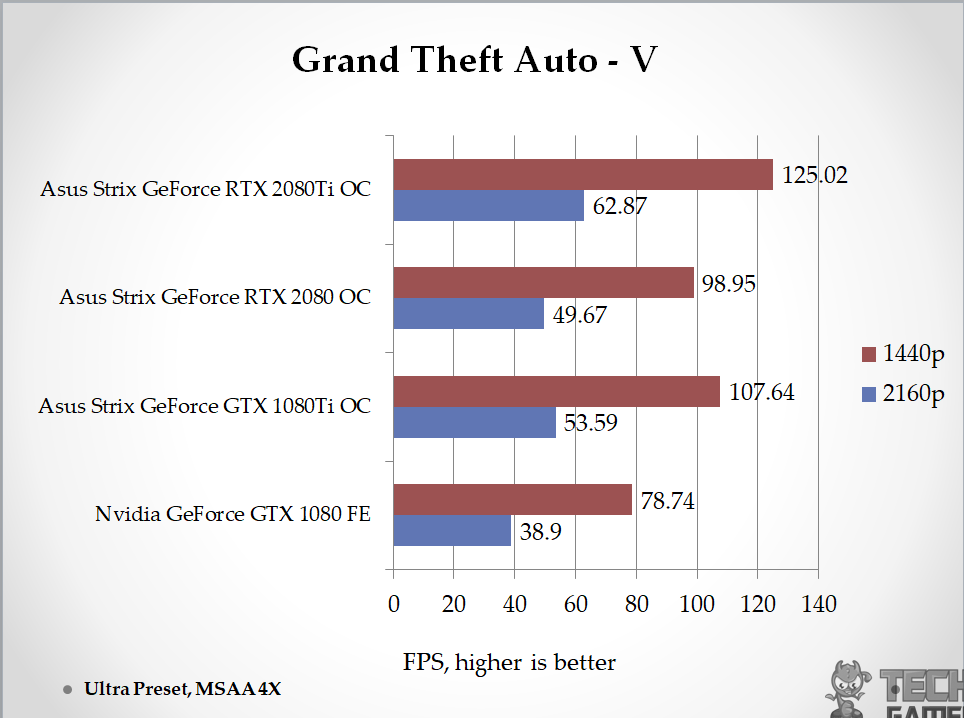
Far Cry 5
On 1440p, the performance gain is 28.44%. At 4K, the performance gain is 31.03%.

Middle Earth: Shadow of War
On 1440p, the performance gain is 32.29%. At 4K, the performance gain is 35.71%.
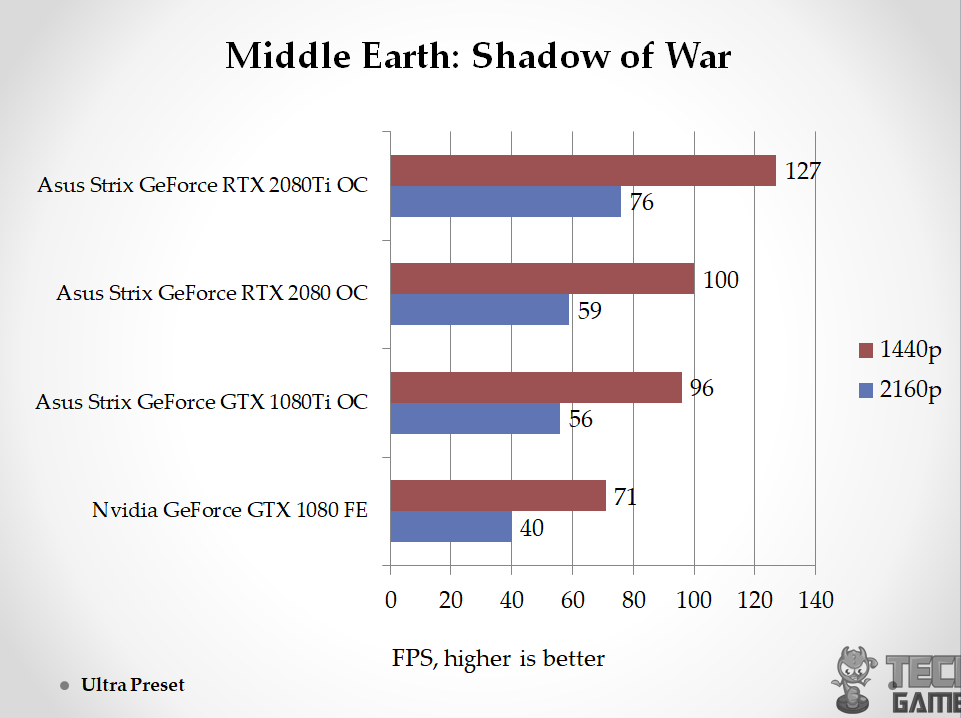
Assassin’s Creed Origin
On 1440p, the performance gain is 20%. At 4K, the performance gain is 24.50%. Despite a lower margin, we have over 60 FPS gameplay at 4K.
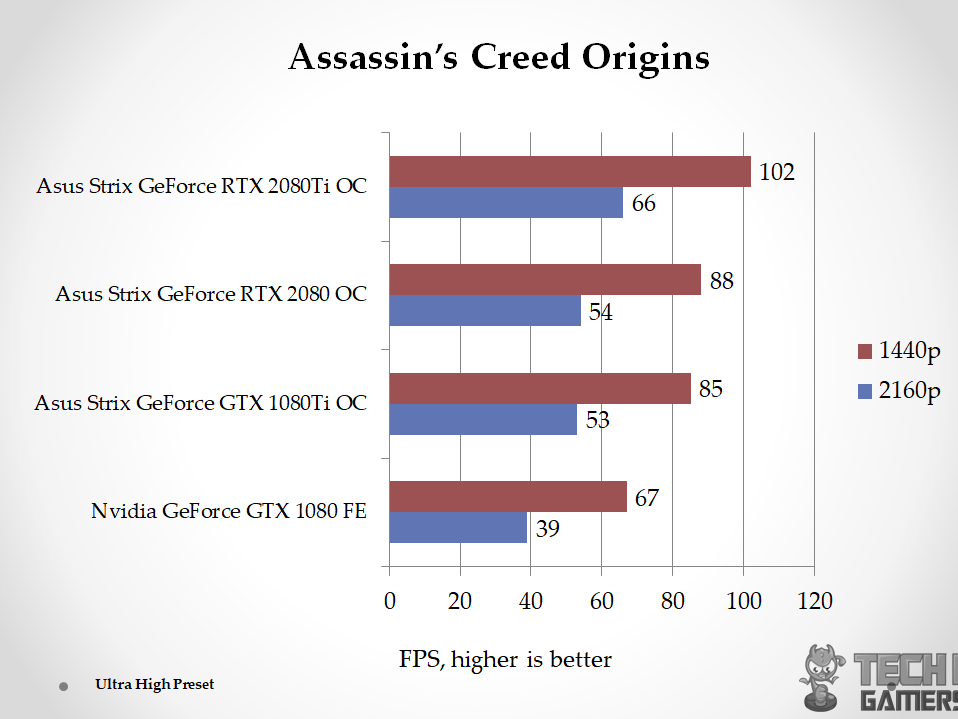
Rise of the Tomb Raider DX11
On 1440p, the performance gain is 19.5%. At 4K, the performance gain is 27.65%.
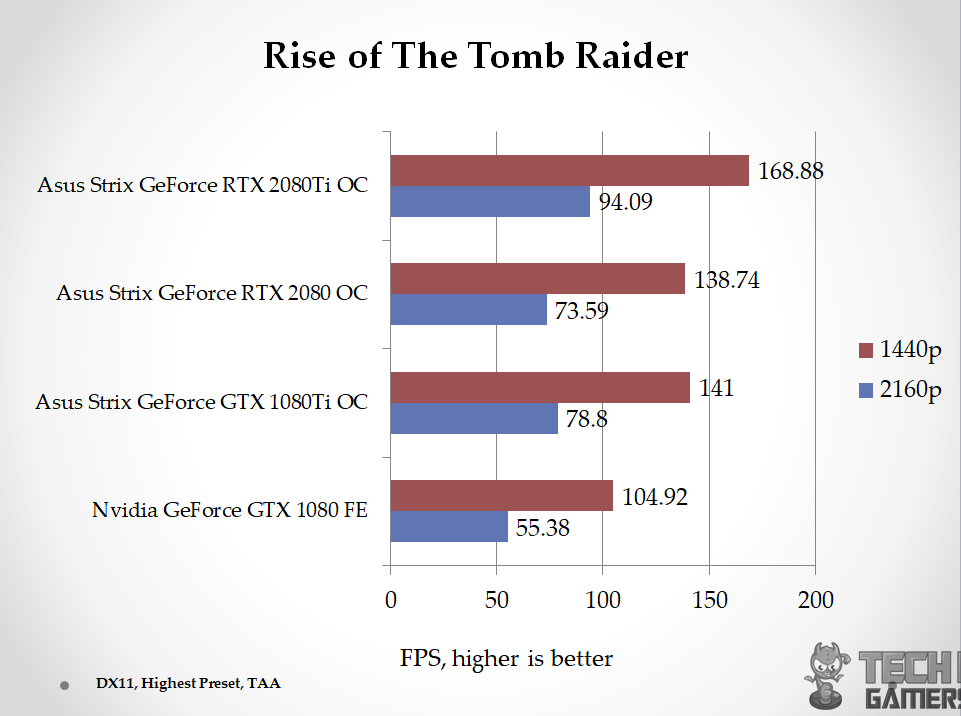
Rise of the Tomb Raider DX12
On 1440p, the performance gain is 19.5%. At 4K, the performance gain is 27.65%.
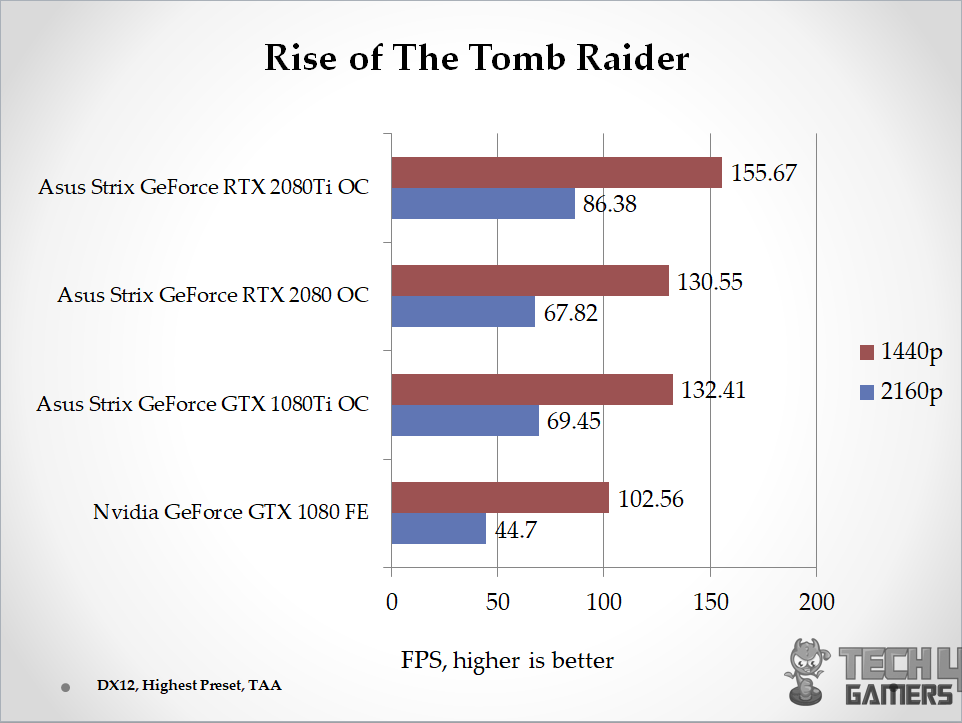
Shadow of the Tomb Raider DX11
On 1440p, the performance gain is 19.77%. At 4K, the performance gain is 19.40.%.
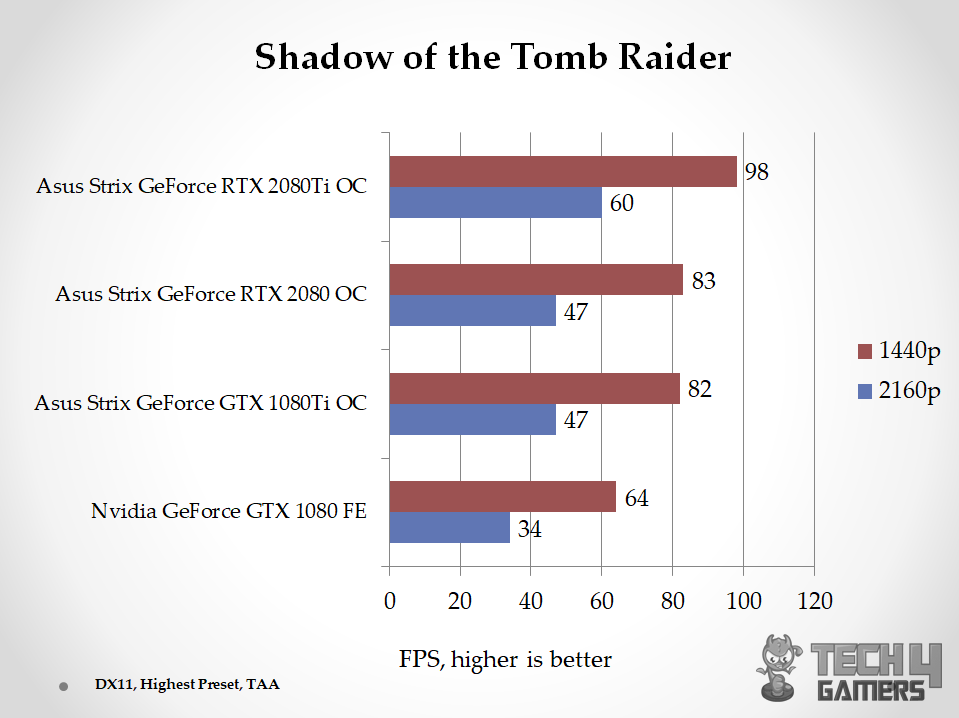
Shadow of the Tomb Raider DX12
On 1440p, the performance gain is 17.56%. At 4K, the performance gain is 24.37%.
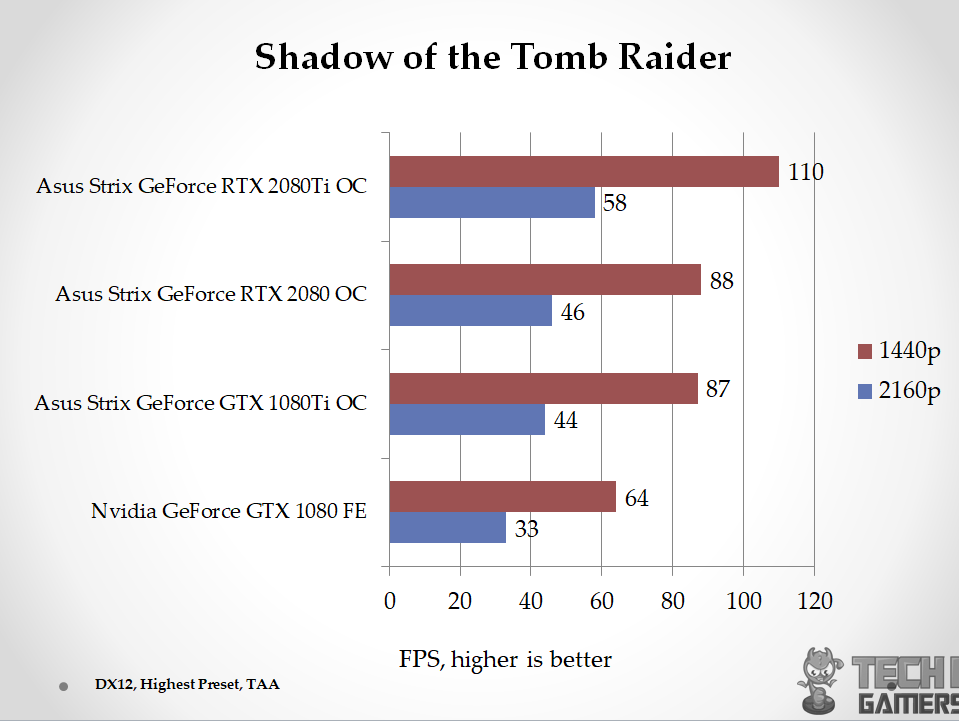
The Witcher 3
On 1440p, the performance gain is 29.57%. At 4K, the performance gain is 29.72%.
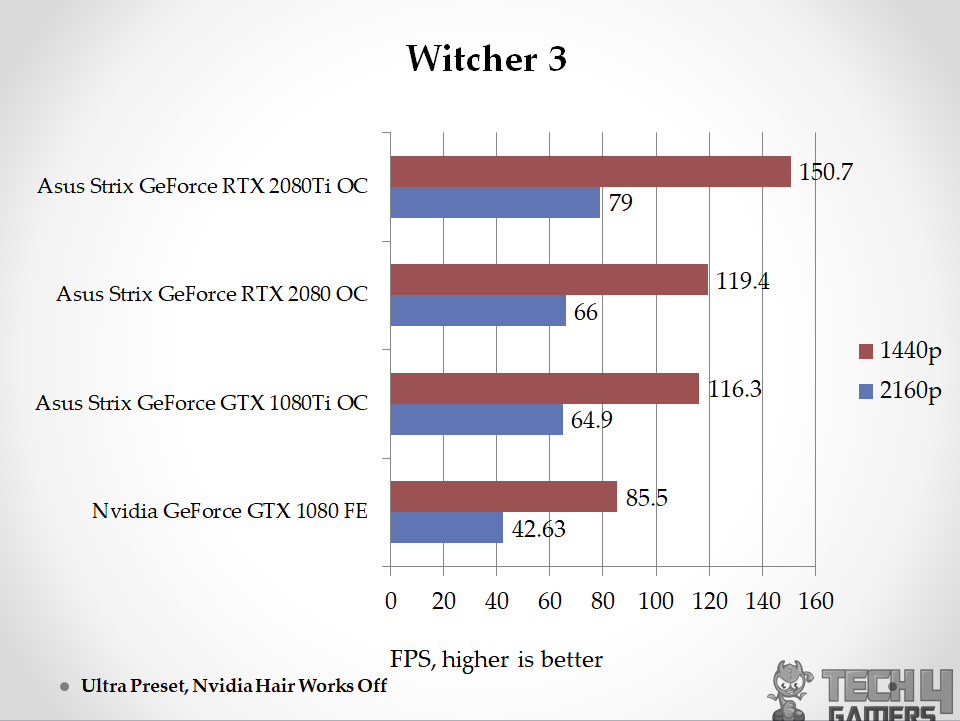
Ashes of the Singularity – Escalation DX11
On 1440p, the performance gain is 10.29%. At 4K, the performance gain is 11.85%.
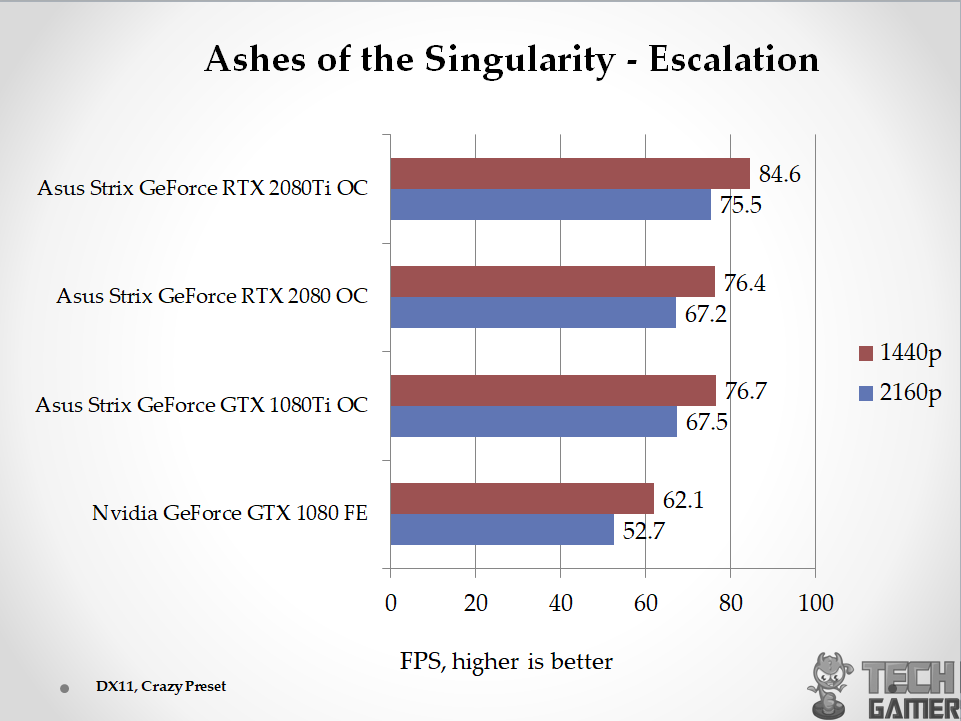
Ashes of the Singularity – Escalation DX12
On 1440p, the performance gain is 20.91%. At 4K, the performance gain is maximum i.e 17.06%.
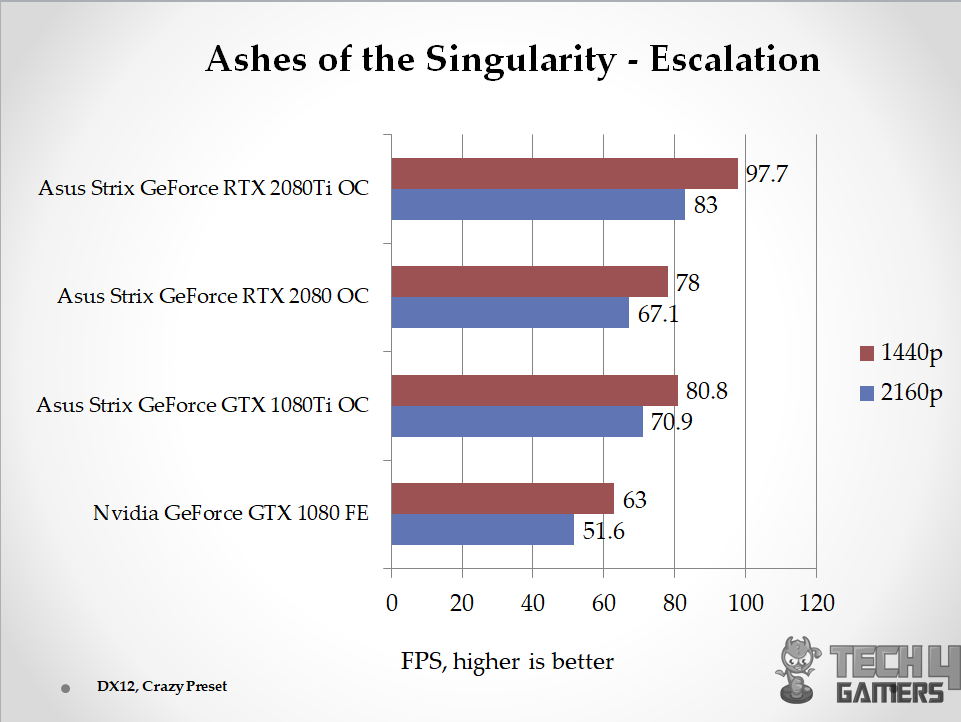
RTX 2080 Ti Overclocking
The Asus Strix GeForce RTX 2080T O11G Review is a factory overclocked graphics card. O in O11G denominates Overclocked edition. In gaming mode, we have 1350MHz base clock which is same as on the Nvidia’s reference design base clock. In OC mode the base clock is 1350MHz as well. The boost clock in Gaming mode (Default) is 1660MHz. In OC mode, the boost clock is 1665 MHz.
Out of the box, the graphics card was boosting to 1950MHz much thanks to the Nvidia’s turbo boost 3.0. But it was not a sustained boost clock. The sustained was like 1905 MHz on average. Overclocking the RTX card seems challenging. I started with the memory overclock first without disturbing the core clock. The voltage was set to the 100% in the GPU Tweak II and Power limit was increased to 125% with 88°C temperature limit.
I managed to get +50MHz on the core clock and +445MHz on the memory clock. Unfortunately, any attempt to go any further was met with artifacts. Surprisingly, the stress test never crashed. With overclocking the maximum boost for once reached at 2070MHz though the clocks were never settled as there was continuous fluctuation with 2025MHz being the lowest.
For this overclocking attempt, the fans were set to run at their max speed which was reported as 3394 RPM. Despite overclocking the results are marginal. Here is the result of the synthetic benchmark with overclocking:
3dMark
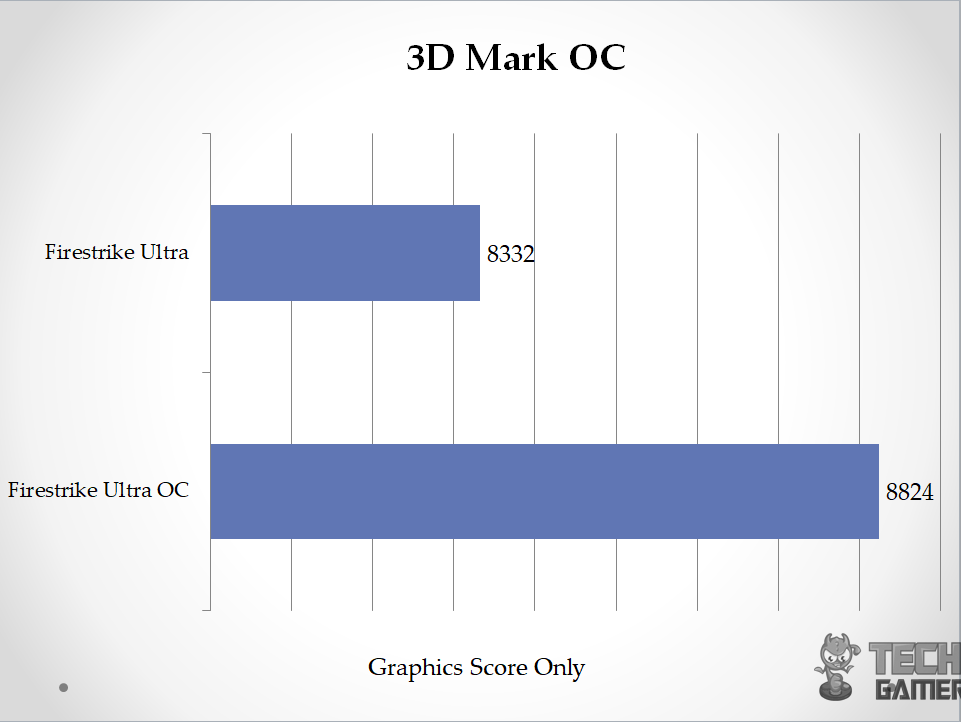
2080 Ti Power Limit
This graphics card was continuously hitting the power limit (not the thermal limit). The total power limit is 125% with 88°C thermal limit. By default power limit is set at 100% and 83°C. I observed the boost clock throttling down to 1750MHz when the graphics card was hitting power limit. Mind you the temperature was 68°C during this time hence thermals have nothing to do with it.
When the power limit was increased to 125% the frequency of the graphics card to hit power limit reduces significantly and maximum drop during the recurrence was 1905MHz. I would suggest the gamers/users set the power limit to 125% all the times regardless of the overclocking.
Geforce RTX 2080 ti Thermals
The graphics card was tested with Furmark run of 10 minutes each at native resolution with 8x MSAA in full screen. For ease of reference, the ambient temperatures are also mentioned. Thermal testing was done with P-Mode and Q-Mode. After each testing minimum of 30 minutes idling was ensured. 79°C was hit under the stress test in Q-Mode.
Keep in mind the ambient temperatures which are reported in the graph for reference. Maximum 69°C was hit in P-Mode. Using Q- Mode will have an impact on the boost clocks as the dynamic nature of turbo boost 3.0 it will clock down as the temperature goes higher. This is how it turbo boost works in the Pascal as well.
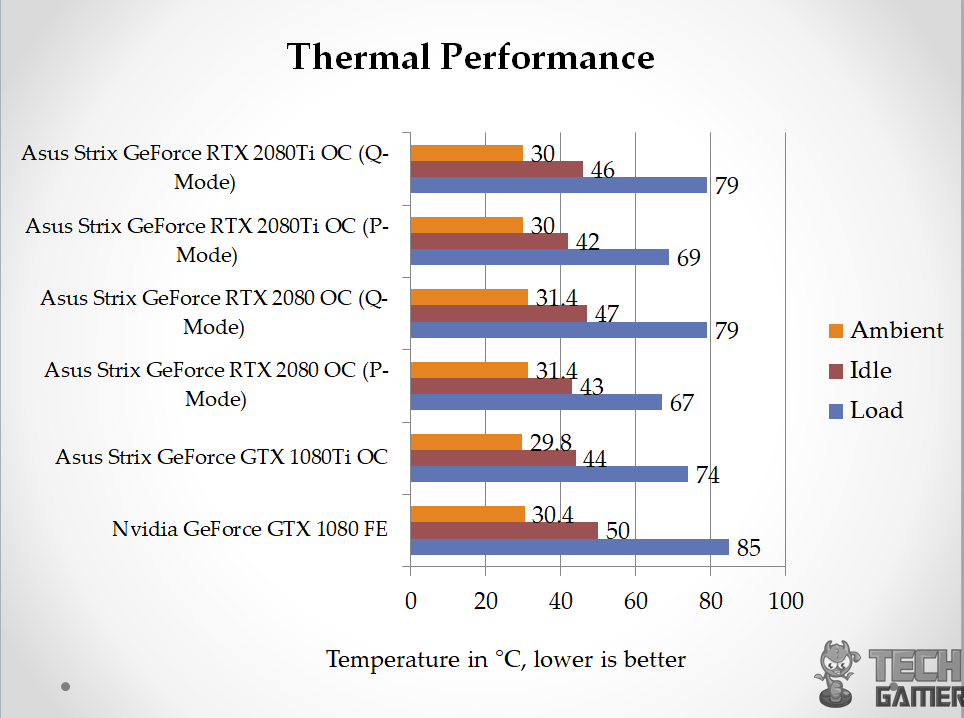
I have tested the graphics card in P and Q modes to check for performance loss if any. For this purpose, Battlefield 1 was used using Ultra settings in DX11 at 4K. Here are the results:
Mode Minimum Boost Clock Maximum Temperature FPS P 1905MHz 69°C 104.9 Q 1785MHz 79°C 102.8
Power Consumption
Effective from first RTX content, I am using HWInfo 64 to record the power consumption of the graphics card. It seems like the HWinfo 64 is measuring the total power draw of the graphics card, not just the GPU. The below graph is showing the power draw of the graphics card only and not of the PC.
The power draw of Nvidia GeForce GTX 1080 FE seems sketchy as the chip itself has TDP of 180W. To measure the power draw on idle, all the background apps were closed and the system was left on idling for 30 minutes. Battlefield 1 in DX11 at 4K using Ultra settings was used to measure the in-game power draw of the graphics card.
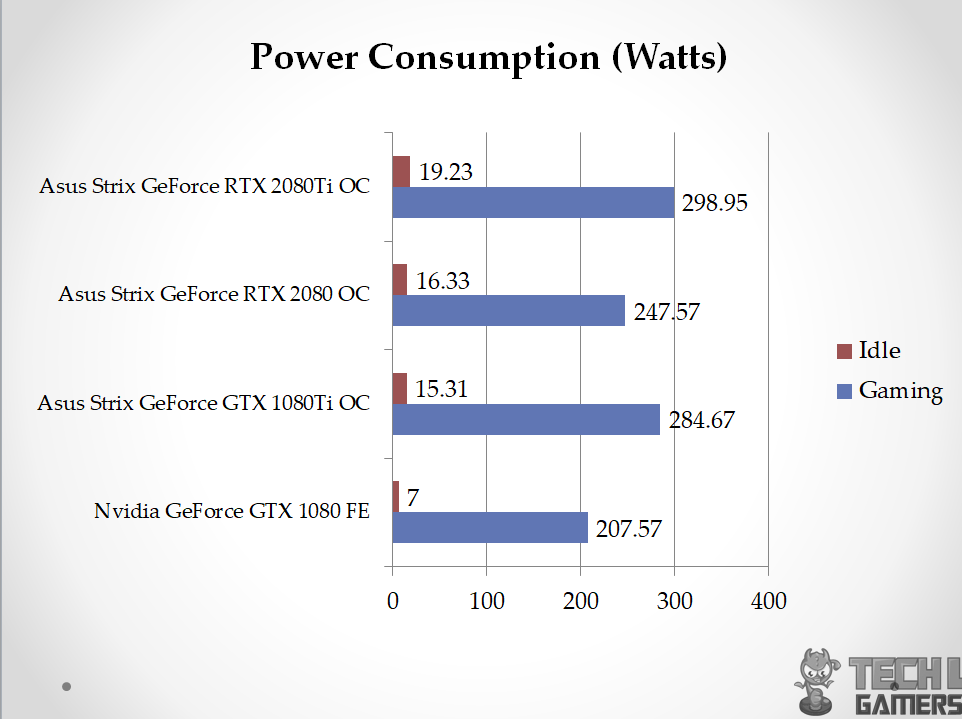
RTX 2080 Ti Acoustics
As the summer season is still here, there is environmental noise that is beyond my control. These sounds will easily invalidate the sound meter testing. The card was tested on an open-air test bench and I am sitting close to my test bench setup. Using my judgment, the graphics card was silent under Q-Mode which is damn impressive but it came at the cost of the 79°C max temperature.
The P-Mode is still not that much audible and with room’s fan powered off and fans on the AIO set at 40% of their speed, the whole room was almost silent and I had to get much closer to the graphics card to hear the fans under the stress test under P-Mode. Asus has definitely done a great job in this department.
Conclusion
The Asus Strix GeForce RTX 2080Ti O11G Review is the second RTX card on my test bench. This card is based on Turing TU102 GPU. The dimension of the graphics card is 12×5.13×2.13 inches or 30.47×13.04×5.41 CM. The card is following the PCIe 3.0 bus interface. It packs 11GB GDDR6 memory chips from Micron rated at 1750MHz using 352-bit bus width at 616 GB/s bandwidth. The base clock of the card is 1350MHz in all the modes.
The default mode is Gaming Mode with 1660MHz boost clock and 1665MHz boost clock under OC Mode. Please, note that you will need to install GPU Tweak II to access these modes. BIOS switch has nothing to do with these modes. Interesting enough this card has 4352 CUDA Cores whereas fully enabled TU102 chip has 4608 CUDA cores. Maximum supported digital resolution is 7680×4320. The card is drawing power using two 8-pin connectors.
This card packs 88 ROP units and 272 TMUs. The pixel fillrate is 118.8 GP/s and Texture fillrate is 367.2 GT/s. Texture fillrate is low as compared to Nvidia’s stated minimum of 420.2 GT/s. This card carries all the bells and whistles of the Turing TU102 GPU including RT Core, Tensor Cores, USB Type-C, VirtualLink, NVLink, New decoder/encoder, DLSS with ray tracing sitting at the core of Turing.
Unfortunately, we have yet to test the true performance potential of these cards due to the lack of games and API enabled for ray tracing and DLSS. For now, the performance comparison is purely from Rasterization factor and new memory architecture and optimization.
The Asus Strix GeForce RTX 2080Ti O11G has retained the basic concept design from Pascal and has brought further improvement. This card features dual BIOS which can be toggled using a switch located on the top side of the PCB. These are designated as P-Mode and Q-Mode. P-Mode focuses on the strong cooling for better performance that may come at more sound level than Q-Mode which aims at bringing the silent operations at the user disposal. However, this is done at the cost of high thermals.
Once the Windows is loaded, switching the BIOS will not take effect until the system is restarted. There is an LED power on/off button located on the backside of the card. Now, the user has the option to turn the lighting off for a pure stealth look. Asus has introduced new Axial-Tech fans in this graphics card which are delivering up to 27% increase airflow and 40% increased static pressure. This is a much-needed requirement as the overall thickness of the heatsink has been increased by 20% hence powerful fans with more static pressure and airflow.
The more surface area in the heatsink has made the overall design of the card to be 2.7 slots. Keep that in mind for clearance issues with respect to the chassis. The length of this card is 12” which is another important factor for clearance. The heatsink has 5 nickel-plated copper heat pipes which seem to be 8mm thick. The middle portion of the heatsink is bit recessed.
There are two nickel plated copper plates on this heatsink. One is making contact with the GPU and the other is making contact with the MOSFET/VRMs. This card is using MaxContact technology that utilizes precision machining to create a heat spreader surface that makes up to 2X more contact with the GPU for better heat transfer.
The backplate is of the same design as we saw on the previous generation Strix cards. This card is using metal brace as an added strength measure to bring reinforcement to the structure that prevents excessive torsion and lateral PCB bending. This card does not have two 4-pin fan headers. There is one 12V GRB pin format AURA header as well. If using this graphics card on Asus AURA Sync enabled motherboard then this would be an added AURA header should one need.
So, the big question! What is the performance like on the RTX 2080Ti? The graphs are self-explanatory when it comes to the Asus Strix GeForce RTX 2080Ti O11G competing against the Asus Strix GeForce GTX 1080Ti O11G. The overall performance gain by the RTX 2080Ti over Pascal’s high-end gaming graphics GPU GTX 1080Ti is approximately 20-25%. This is not that much of a significant gain that one would have expected.
However, the real performance is still to be tested using the new technology and features which will be done when enabled games will be available. Nvidia has not only brought further graphics processing improvement in Rasterization but they have implemented dedicated hardware for Ray Tracing and Artificial Intelligence (Tensor Cores).
DLSS is expected to bring better graphical processing with more efficiency and ray tracing which is a computationally intensive task, has been implemented in a dedicated hardware which would relax the main GPU to focus on more traditional processing. Further, they are implemented in a hybrid approach where the load will be shared depending upon the task requirement.
The current performance gain is coming from Rasterization only. We are expecting better performance gain and efficiency once new technology will be put to use. I am looking forward to the time where we will be testing them to bring forward true performance potential of the Turing based graphics cards. Asus is offering limited 3 years limited warranty on the Strix GeForce RTX 2080Ti O11G which is nice.
This card will retail at Rs.198000/- when it will be launched in the local market which is a jaw-dropping price. If you are using GTX 1080Ti then I would suggest waiting till we get to see the RT and DLSS in testing.
I am thankful to the Asus Pakistan for giving me the opportunity to review their Asus ROG Strix GeForce RTX 2080Ti O11G.
Check Price on Amazon

Top 4 rtx 2080ti tổng hợp bởi TOPZ Eduvn
GeForce RTX 20 Series
- Tác giả: nvidia.com
- Ngày đăng: 07/02/2022
- Đánh giá: 4.9 (765 vote)
- Tóm tắt: Discover high-end laptops and graphics cards for gaming with NVIDIA GeForce RTX 20 series, powered by Turing microarchitecture, real-time ray-tracing and AI
Galaxy Microsystems Ltd.
- Tác giả: galax.com
- Ngày đăng: 10/25/2022
- Đánh giá: 4.65 (220 vote)
- Tóm tắt: Those records are about to be broken as the brand-new GALAX GeForce RTX 2080 Ti HOF is ready to show the world what it can do. Product Code 28IULBUCV6DH UPC …
Rtx 2080 ti – Prices and Deals – Apr 2023 | Shopee Singapore
- Tác giả: shopee.sg
- Ngày đăng: 12/19/2022
- Đánh giá: 4.57 (544 vote)
- Tóm tắt: Find attractive rtx 2080 ti prices when shopping for products on Shopee Singapore! Enjoy deals on products and securely pay for your rtx 2080 ti with Shopee …
TURBO-RTX2080TI-11G
- Tác giả: asus.com
- Ngày đăng: 07/14/2022
- Đánh giá: 4.15 (383 vote)
- Tóm tắt: ASUS Turbo GeForce RTX™ 2080 Ti 11GB GDDR6 with high-performance blower-style cooling for small chassis and SLI setups. NVIDIA TURINGTM:ASUS GeForceRTX™ …
- Khớp với kết quả tìm kiếm: The P-Mode is still not that much audible and with room’s fan powered off and fans on the AIO set at 40% of their speed, the whole room was almost silent and I had to get much closer to the graphics card to hear the fans under the stress test under …
